The adventures of Rusa in Toontown (the ninth instalment)
Catching the last bit of the 2× Trap XP Silly Meter reward, I did unlocc that sweet, sweet TNT, as promised:

Yes!! Now I can blow some Cogs the flunk up!!! And just in time, too. In particular, just in time for a change of scenery…
To ſleepe, perchance to Dreame
Donald’s Dreamland — or DDL, for short — is the final neighbourhood. The Brrrgh taught us everything that there is to know about gags, & DDL is here to put that knowledge to the test.
Of course, this is not Donald Duck’s only neighbourhood; there’s also Donald’s Dock (DDock). But I don’t hesitate to claim DDL as my favourite neighbourhood in all of Toontown. If I had to live somewhere in Toontown, it would be here.

DDL is the neighbourhood of sleep, dreams, night, & everything in between. The colour palette is based around a deep, dusky purple. As can be seen in the above image, the playground is actually just one giant bed. The multicoloured patchwork quilt forms the floor, on the right we can see the white fluffy pillow, & on the left (this isn’t a great image to show this part) we can see some of the wooden bedframe, complete with posts & headboards. The Toon HQ wears a purple nightcap, & the buildings have drowsy looks to them, their windows like eyes with awnings for eyelids.
As I briefly discussed in the “A brief primer on the Earthly consequences of CBHQ (& LBHQ, & BBHQ)” section of the fourth instalment, DDL has only two egresses now, but originally it had just one (making it effectively a cul-de-sac)! DDL’s Lullaby Lane connects to MML’s Tenor Terrace, but the only other DDL street — viz. Pajama Place — leads to CBHQ, which wasn’t released until .
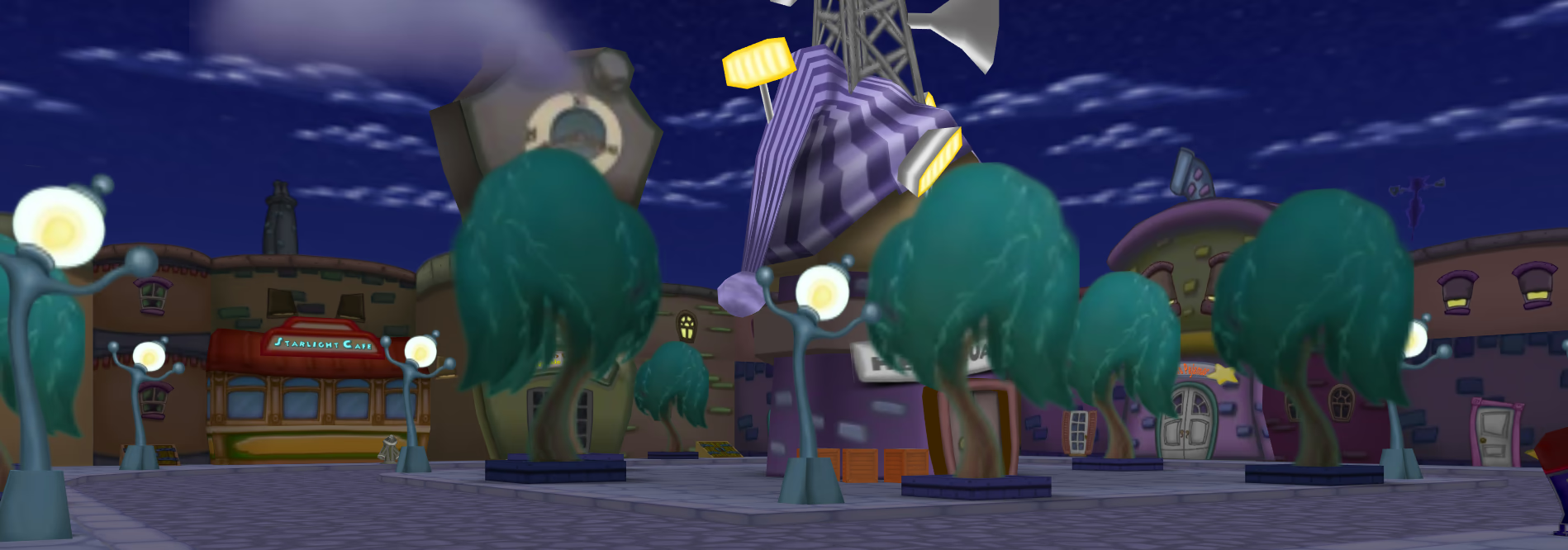
DDL is permanently plunged in dusky nighttime & fluffy purplish clouds, & its streets are even moodier than its playground. They’re home to sleepy trees, many more somnolent Toon Buildings, streetlamps, mailboxes, & fire hydrants, and the highest-level Cogs & Cog Buildings of any neighbourhood in the game. They’re also home to a small handful of strange criss-crost alleyways & dead ends:
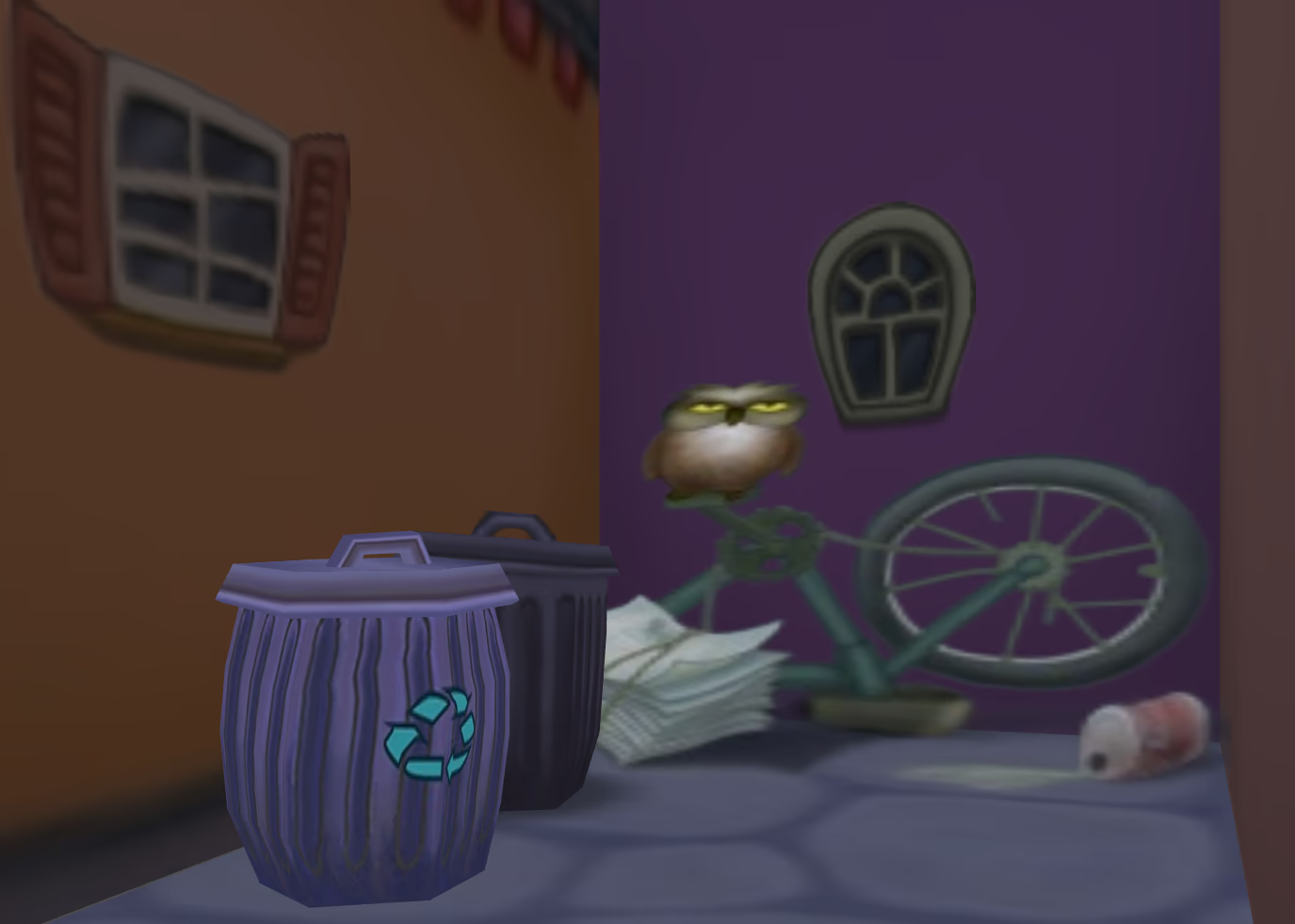
Maybe the mouldy low-resolution textures hamper it a bit, but I think we can agree that DDL is the thematically superior neighbourhood…
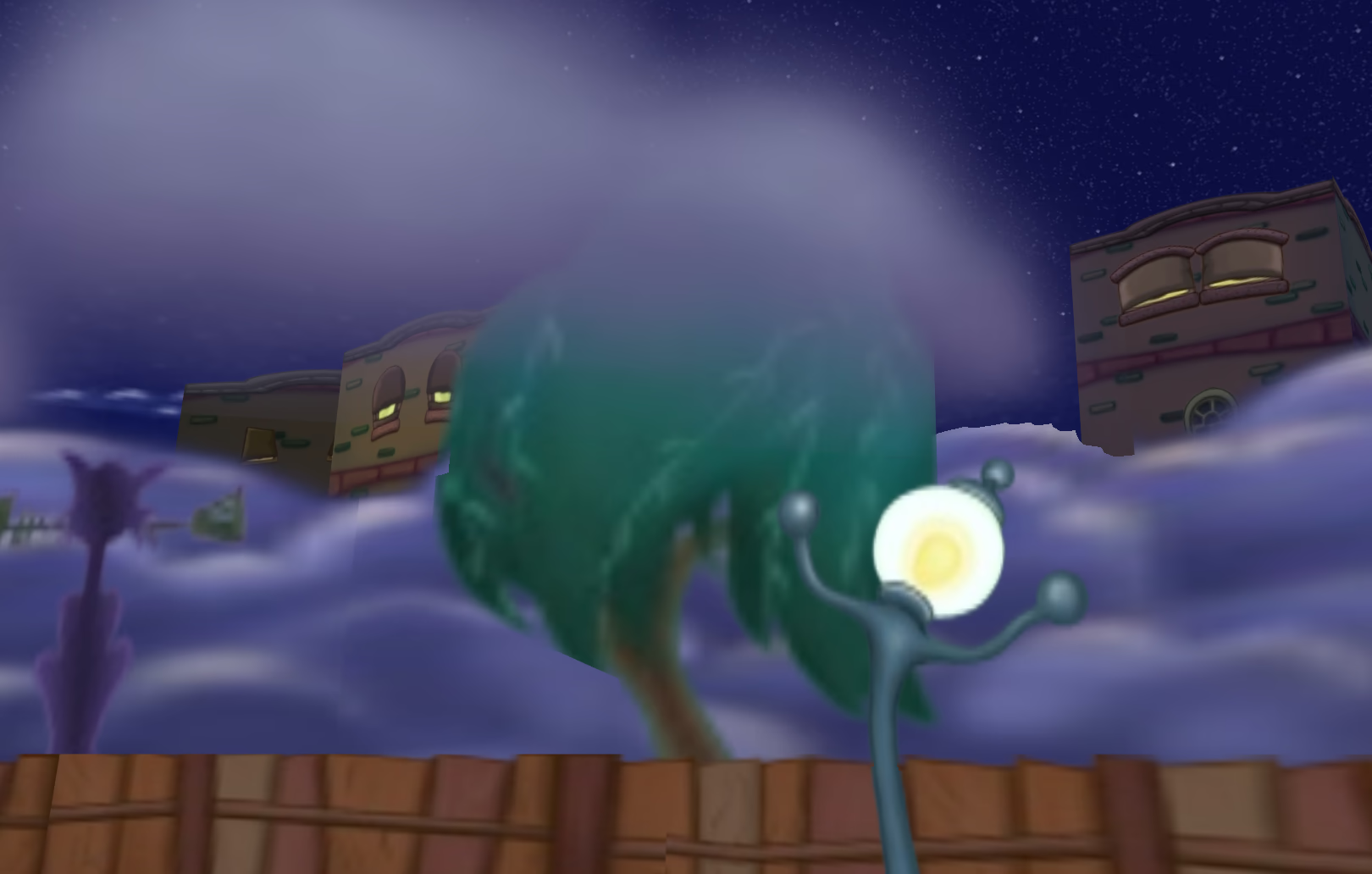
The above image is taken from the fishing pond on Lullaby Lane, whose attendant fisherman is Fisherman Taylor. The other fishermen of DDL are none other than Fisherman Freud & Fisherman Jung, named for Sigmund Freud & Carl Jung, respectively. The use of these two names stems from their respective influential theories of dream interpretation (see, especially, Die Traumdeutung (1899)).
And needless to say, the shop names are fantastic as well. My personal favourite is this one:

Forty winks is an English idiom meaning “brief sleep”. So many winks for the price of just twenty is quite the screamin’ deal — a steal, even — but my obsession with this Toon Building actually stems from a misreading. I must have misread ⟨Price⟩ as *prince somehow, at some point, & in spite of the total lack of relation between these two words, the result somehow still makes sense[8]: a brief sleep for a young (of twenty meaning “of twenty years”) prince. I don’t know who “the prince” of DDL is (Donald himself, perhaps?), but I’m glad that he’s getting some rest.
DL_SZ

Pipe Dream Plumbers on Pajama Place, operated by Jane Drain. A pun on the English idiom pipe dream “plan, wish, or idea that is implausible” (1870), from the notion of something dreamt up whilst smoking opium.
OE had the etymologically equivalent pīpdrēam /ˈpiːpˌdræːɑ̯m/, but this instead meant “pipe [the musical instrument] music”, from the OE sense of drēam “music; merriment”. All other Germanic languages (except apparently Old Saxon, another Ingvæonic language, which had the “dream” sense also) have the “dream” sense only, implying that OE probably had the *“dream” sense also, in spite of it not being attested. Either that, or it was borrowed back from a cognate (presumably ON draumr).
And sure, the textures might be a bit mouldy here & there, but there’s no mould to be found in DDL’s music. Quite the contrary; the music is a big part of what makes DDL stand out so spectacularly. Back in the “DD_SZ” section of the third instalment, I picked apart one of the little tunes that makes Donald’s Dock special to me, so I think it’s only fitting that I do the same for Dreamland.
It’s not easy to pick just one tune! Although there are only three, each clocking in at a little over half a minute… We’ll go with the “street zone” (I assume that’s what SZ stands for)[1] one, partly to match the DDock one, & partly because of its very strong start.
As far as I can tell, this piece was composed by James T. Sale.
Once again, we have the original MIDI data for this tune (see DL_SZ.mid), so all that I did was import it into MuseScore 4, & then painstakingly clean it up (& reduce it a bit) into a really readable score. It’s worth noting that, with only some minor tweaks, MuseScore 4’s built-in playback is actually — in my opinion — even more beautiful than the original, which is presumably using something like Microsoft™ GS Wavetable Synth or whatever. But the above audio is just the original, as that’s the most important version here.
ℹ️ This section contains some (rudimentary) music theory, but the reader should be able to follow along with some effort. <a> & <abbr> elements are provided.
Overarching structure
I’ll be breaking up the form of this tune into basically a bar form: ⟨AA′B⟩.
⟨A⟩
ℹ️ The celesta part sounds one octave higher than written, & is also written using an 8va treble clef (“sopranino clef”), not an ordinary treble clef. The piano part is written on a grand staff with an 8va treble clef & ordinary treble clef, rather than the usual ordinary treble clef & bass clef, respectively. Also, the exact time at which each synthesizer note “stops” is not terribly clear, so the way that I’ve written it is basically arbitrary.
In ABC notation
%abc-2.2
X:1
T:DL_SZ, ⟨A⟩ section, main texture
C:James T. Sale
O:Donald’s Dreamland
Z:deer
%%score 1 { 2 | 3 } { 4 | 5 } 6
L:1/8
Q:1/4=132
M:3/4
I:linebreak $
K:F
V:1 treble+8 score=c' nm="Celesta" snm="Cel."
V:2 treble+8 nm="Piano" snm="Pno."
V:3 treble
V:4 treble nm="Harp" snm="Hrp."
V:5 bass
V:6 treble nm="Synth" snm="Syn."
[V:1] fa c'f' a'c'' | a'f' c'a fa | eg c'e' g'c'' | g'e' c'g eg |
[V:2] f4 A2 | f4 A2 | e4 G2 | e4 G2 |
[V:3] FA cc' f2 | FA cc' f2 | EG cc' e2 | EG cc' e2 |
[V:4] [Fa]2 [Af][ca] [Af]2 | [Fa]2 [Af][ca] [Af]2 | [Eg]2 [Ge][cg] [Ge]2 | [Eg]2 [Ge][cg] [Ge]2 |
[V:5] [F,,F,]4 [A,,A,]2 | [F,,F,]4 [A,,A,]2 | [C,,C,]4 [E,,E,]2 | [C,,C,]2 [D,,D,]2 [E,,E,]2 |
[V:6] [cfa]6 | z6 | [ceg]6 | z6 |
Tonal material
Tonally, the ⟨A⟩ section could scarcely be simpler.
Measures 1〜2 consist entirely of the pitch-classes {F, A, C}, i.e. an F major triad. The bass part — played on a harp — mostly plays F, thus effectively putting this chord in root position.
Measures 3〜4 basically do the same thing, but with the pitch-classes {C, E, G} instead, with mostly C in the bass. That is, a C major triad in basically root position. The only exception is a single lone D in m. 4, played in the bass part to pass between (this is a textbook example of a passing tone) C → E.
This puts us firmly in the key of F major, where this progression would be analysed in Roman numerals as I – V (functionally T – D).
Voice leading
Even with this very limited & simple tonal palette, there are still somewhere between five & eight (depending on how you count) melodically independent parts already!
The synthesizer plays a very simple pair of block chords, putting C on the bottom, & then moving the other two voices stepwise in parallel thirds. This exploits the fact that the F & C chords share a common tone of C, to produce this highly economical motion. By contrast, the celesta part plays only single notes, outlining huge arpeggios in eighth notes.
Also note that the common tone of C is exploited in the piano part as well, allowing for the same octave skip upward from C → C in both mm. 1〜2 and mm. 3〜4.
This leaves the piano & harp parts, which are somewhere in between in terms of voice leading. Both parts each consist of essentially two independent melodic lines, although the harp part features parallel sixths quite heavily in mm. 1〜2.
What’s impressive about this is that, in spite of so many moving parts, everything (even the piano & harp parts) interlocks quite nicely, with almost no undesirable consecutives between independent parts: no parallel fifths, fourths, octaves[2], nor even hidden consecutives as far as I can tell!
The sole exception (again, as far as I can tell) is in the harp part of mm. 3〜4, where C & G are played simultaneously in the second half (the “&”) of the second beat, forming a perfect fifth (P5) approached by similar motion, which is technically a hidden consecutive fifth. Also note that the aforementioned octave skip upwards briefly causes two voices to cross. Still, it’s pretty impressive, & I think it sounds very good!
It’s also worth noting that the transition from m. 4 to m. 1 (V → I, i.e. a perfect authentic cadence) is particularly smooth on account of two melodic gestures already established earlier on:
- The celesta part climbs straight up & then straight down, but then goes up just once at the end of each such phrase. This apparent disjunction causes the melodic sequence E → G → F in the m. 1 → m. 4 transition, which is what I like to call a surrounded tone, because the F is “led into” by not just one, but both of its neighbouring tones. Thus, the skip from E → G which would normally be justified by the fact that this part is playing arpeggios, is now heard melodically as a skip that is “justified” (in the Common Practice (CPP) sense) by an immediately subsequent step in the opposite direction.
- The bass part moving up to the 3rd factor on the final beat of each measure causes the F in the bass part of beats 1〜2 of m. 1 to be approached by its leading-tone. Moreover, the aforementioned D passing tone makes this melodic motion particularly obvious & smooth.
Orchestration, texture, & timbre
This is Donald’s Dreamland, so the music is consciously attempting to evoke a dreamlike quality. To that end, we have a number of orchestral, textural, & timbral decisions:
- The most prominent part so far is certainly that of the celesta, on account of its highest pitch, & its highest amount of movement (ceaseless eighth notes). The celesta was popularised by Tchaikovsky[3] in his The Nutcracker[4] (1892), & remains firmly associated with it to this day. The Nutcracker takes place within a child’s imagination, making the celesta a perfect fit for evoking this quality.
- To maintain the lofty & ethereal vibe, there’s basically no percussion in the entire piece. The closest that we get is of course the aforementioned celesta part, which is technically a struck idiophone (specifically H–S 111.222-8 “set of percussion plaques with keyboard”), but is not conventionally heard as percussion. It’s a keyboard instrument, high-pitched, & also very clearly pitched (emphatically not an unpitched percussion instrument), so there is no percussive “drive” to the piece.
- The synthesizer uses an ethereal echo-y patch that causes its part to add a sparse “clouding” (if you will) effect.
- Although there are pitches in the bass register, they’re quite sparse, & played in only the harp part. This is enough to “fill in the low end” to a decent degree, but the sparseness, in combination with the harp having a naturally soft timbre, allows the piece to remain firmly focused on the high frequencies, thus lending a “lightweight” feel.
Metre
The time signature & corresponding metre are well-described by . In CPP, rhythmically slow pieces in this kind of triple metre are often waltzes, or are at least associated with a waltz. However, this is not necessarily a waltz, as particularly evidenced by the beat sequence ⟨down, (down), up⟩, as opposed to the characteristic waltz sequence ⟨down, up, up⟩. That being said, this piece can certainly be danced as a waltz, so there’s still some affinity.
When I listen to the piece, the use of in this ⟨down, (down), up⟩ pattern makes it feel somehow “slower” than it actually is, which is a somewhat brisk 132 BPM (likely marked as allegro). The sluggish harmonic rhythm & whiff of a waltz feel, when taken in combination, make the piece almost feel more “stretched out” during the ⟨A⟩ & ⟨A′⟩ sections, lending a further dreamlike time distortion to the piece.
Lead melody
ℹ️ The numbers in the following score are scale degrees relative to a major scale starting on the root of the chord. For example, a minor third (m3) above the root is written “♭3”, even if the chord has a minor or diminished quality. Non-chord tones (NCTs) are indicated in a somewhat different colour than their chord factor siblings. Pitches sound as written.
In ABC notation
%abc-2.2
X:2
T:DL_SZ, ⟨A⟩ section, lead melody
C:James T. Sale
O:Donald’s Dreamland
Z:deer
L:1/8
Q:1/4=132
M:3/4
I:linebreak $
K:F
V:1 treble nm="Clarinet in C" snm="Cl. in C"
F2 A2 f2 | c2 BA GF | E2 G2 e2 | c2 GF E2 |
Parsons code: *uudddddduudddd(u).
This clarinet part provides the lead melody for the ⟨A⟩ section. It broadly follows the “rising → falling” contour of the celesta part, but is largely independent of it, with the slight exception of a few hidden consecutives here & there.
Tonally, this melody tends to stick to chord tones. However, m. 2 is perhaps the spiciest due to having two NCTs (viz. the 4th & 2nd degrees) that are somewhat emphasised, due to landing directly on beats.
I think what makes this melody strong is that it does the little trick of starting out with a big upward climb; in this case, climbing up by a full octave before the end of the first measure. Although this introduces fairly large skips, a lot of notes are spent climbing back down very carefully, & the transition from one chord to the other is always done by step.
Moreover, it follows broadly the same motion in mm. 3〜4 when compared to mm. 1〜2, making this work by starting on the 3rd factor instead of the 1st. There’s also the disparity of the second half ending with a quarter note instead of two eighth notes, which is necessary to produce that smooth looping back around to m. 1 (via the leading-tone, of course).
⟨A′⟩
In ABC notation
%abc-2.2
X:3
T:DL_SZ, ⟨A′⟩ section, lead melody
C:James T. Sale
O:Donald’s Dreamland
Z:deer
L:1/8
Q:1/4=132
M:3/4
I:linebreak $
K:F
V:1 treble nm="Clarinet in C" snm="Cl. in C"
V:2 treble nm="Trumpet in C" snm="Tpt. in C"
[V:1] !fermata!F6 | z6 | z6 | z6 |
[V:2] A2 c2 f2 | a2 gf ed | c2 e2 g2 | e2 cB A2 |
Parsons code: *uuuddddduudddd(r).
This section differs from ⟨A⟩ in that the lead melody is somewhat altered & is now played by a trumpet (instead of a clarinet), & also in that the harp part loses its upper voices, paring it down to just the octave-doubled bassline.
The contour of this melody is broadly similar to that of ⟨A⟩’s, but we do see (amongst other things) the first appearance of the 6th & 7th degrees/factors of the underlying chords. Note that I’ve marked the B♭ in m. 4 as an NCT, because in this context it technically is, but ordinarily it would just be the 7th factor of a dominant seventh chord.
Although this version of the melody might appear to have a weaker ending (the (r) in the above Parsons code), it’s just because this version only plays once, so that last A♮ is intended to lead into the ⟨B⟩ section.
⟨B⟩
ℹ️ A superscript “6” here does not denote that the chord has a sixth factor (that would rather be indicated by an ordinary script “6”), but instead denotes the first inversion. See: figured bass. All pitches sound as written, except the glockenspiel part, which sounds an octave (not two octaves) higher than written, like the celesta part.
In ABC notation
%abc-2.2
X:4
T:DL_SZ, ⟨B⟩ section
C:James T. Sale
O:Donald’s Dreamland
Z:deer
%%score 1 2 3 4 5
L:1/8
Q:1/4=132
M:3/4
I:linebreak $
K:F
V:1 treble nm="Clarinet in C" snm="Cl. in C"
V:2 treble nm="Trumpet in C" snm="Tpt. in C"
V:3 treble score=c' nm="Glockenspiel" snm="Glock."
V:4 bass nm="Harp" snm="Hrp."
V:5 treble nm="Violins" snm="Vlns."
[V:1] B2 d2 b2 | g2 d2 B2 | c2 e2 a2 | g2 e2 c2 |
[V:2] !fermata!B6 | z6 | z6 | z6 |
[V:3] B2 d2 b2 | g2 d2 B2 | c2 e2 a2 | g2 e2 c2 |
[V:4] [B,,,B,,]4 [D,,D,]2 | [B,,,B,,]4 [D,,D,]2 | [C,,C,]4 [E,,E,]2 | [G,,G,]2 [E,,E,]2 [C,,C,]2 |
[V:5] [FBd]6 | [GBd]6 | [EAc]6 | [EGc]6 |
%
[V:1] B2 d2 b2 | d'2 b2 g2 | c'2 a2 e2 | c2 e2 g2 |]
[V:2] z6 | z6 | z6 | z6 |]
[V:3] B2 d2 b2 | d'2 b2 g2 | c'2 a2 e2 | c2 e2 g2 |]
[V:4] [B,,,B,,]4 [D,,D,]2 | [B,,,B,,]4 [D,,D,]2 | [C,,C,]4 [E,,E,]2 | [G,,G,]2 [E,,E,]2 [C,,C,]2 |]
[V:5] [DFB]6 | [DGB]6 | [CEA]6 | [CEG]6 |]
Broadly speaking, the immediately identifiable differences from the ⟨A′⟩ section are as follows:
- The main melodic instrument has switched back from the trumpet to the clarinet. But also, the clarinet is now doubled by a piccolo & a bassoon. Because this doubling is almost purely timbral, it’s not represented in the above score, for readability.
- The clarinet is also doubled by a glockenspiel, but this is represented in the above score, because it’s really a continuation of the celesta part.
- The synthesizer part has been replaced by a trio of violins played arco.
- The harmonic tempo has doubled.
Tonal material
As indicated in the above score, the basic harmonic progression here is as follows:
| measure | 1 | 2 | 3 | 4 |
|---|---|---|---|---|
| chord | B♭ | G−6 | A−6 | C |
| Roman | IV | ii6 | iii6 | V |
| function | S | Sp | Dp | D |
Because we only saw the I & the V throughout ⟨AA′⟩, three of these four chords are technically new to the piece. Nevertheless, I think that the analysis can still be made simple.
These four chords are really just an elaboration of IV – V, as indicated fairly overtly by the bass movement. The implication is preparation for your classic straightforward IV – V – I; this music is intended to be looped, after all! This would functionally just be S – D – T, which is really the very paradigm of Western tonality.
If you’re confused as to how ii6 & iii6 fit in here, just think of them as like IV & V respectively, but with a single extra note built a third down from the root, in addition to building upwards in the usual tertian way. The fact that these are in first inversion puts their “functional roots” (rather than the roots of the chords strictō sēnsū) in the bass, which makes this phenomenon particularly obvious. These chords are relative to IV & V respectively, in the same way that A minor is the relative minor of C major.
Voice leading
We saw that the ⟨A′⟩ section somewhat unexpectedly ended on an apparently “weak” A♮ in the lead melody (i.e. the trumpet part). But we can now see that this was simply preparing for the ⟨B⟩ section, which starts on a B♭ major chord, thus making A♮ actually the perfectly strong leading-tone.
The other main voice-leading concern here is between the three violin parts. We can easily hear, & see at a glance of the score, that the voice movement is fairly economical! Upon further inspection, the voice leading is, as you’d expect, very strong between the closely-related (relative) chords.
However, between the subdominant & dominant (or vice versā), we get some hidden consecutives (& actually a full-blown parallel fourth across the m. 4 → m. 5 barline in the above score). Still, the classical voice leading “violations” are fairly trifling; they’re all parallel perfect fourths (P4s), hidden or not, which may be considered acceptable even in many CPP styles.
Orchestration, texture, & timbre
The clearly “chordal” texture is now taken up by the violins, with a single block chord per measure. This supplants ⟨A⟩’s paradigm of a more melodico-rhythmically elaborate chordal texture upheld by multiple voices across the harp & piano. This leaves the harp part as purely a bassline, and creates a stronger contrast between “melody” & “accompaniment”.
This stronger contrast is further emboldened by the lead melody being doubled so aggressively. We have four parts — clarinet, glockenspiel, piccolo, & bassoon — all doubling each other at unisons/octaves.
The switch from celesta to glockenspiel is a minor timbral one here; indeed, the glockenspiel is playing in the lower end of its range, so there’s not really a registral difference. Similarly, the piccolo blends well with the clarinet, & plays in the same range as the glockenspiel. Perhaps the most significant “doubling” here, then, is that of the bassoon, which is playing in its usual bass register.
The bassoon, in reaching down towards the harp’s register, makes it particularly clear what’s really going on here. Although the aforementioned strengthening in contrast between “melody” & “accompaniment” is certainly real, the “lead melody” here actually has the melodic rhythm & motion of the ⟨AA′⟩ melodies ironed out of it entirely; it’s just straight quarter note arpeggios & nothing else. The result is thus not quite “homophony” in the usual sense, but rather has the lead melody competing with — & sometimes polyphonically contrasting with — the harp’s bassline.
This broken style — “broken” in the sense of broken chords & the sense of style brisé — is rigid, almost stilted, & adds to the harmony’s distinct sense of interregnum. As the harmony oscillates between subdominant & dominant (refusing to express the tonic), the melody similarly refuses to contrast with itself rhythmically & intervalically, making the entire ⟨B⟩ section feel eerily static.
This static feeling apparently conflicts with the more swift (in comparison to ⟨AA′⟩) harmonic tempo. In some ways, the result, I think, gets even closer to evoking a dreamlike quality. The eerie tonal stagnation, brisk movement, & floaty disposition produce a lack of narrative, so that the listener is simply confronted by each measure in succession. This arbitrary succession of events “just happens”, much like in dream, where there’s no need for an obvious logical connexion between successive events.
Lead melody
Parsons code: *uuddduuudddduuudduddduu(d).
This brings us to the lead melody itself. As mentioned, there are only quarter notes. The overwhelming use of skips (rather than steps) suggests arpeggiation, & indeed, the melody consists exclusively of chord tones. Because we’re working with triads, this limits the melody to a maximum of three distinct pitch-classes per measure, which is fairly restrictive, but is an exact match for the exclusive use of quarter notes (in ).
If we think in terms of pitch-classes, we can count the total number of distinct possibilities for a given measure. With the restrictions as stated, it’s obvious that there are 33 = 27 such possibilities. However, we can see that the melody limits itself to always moving, never playing the same pitch-class more than once in a row. With this additional restriction, we actually only have 3 ⋅ 2 ⋅ 2 = 12 possibilities. This number reduces to just 23 = 8 if the previous measure ended on a pitch-class that is a chord tone for the current measure.
Of the aforementioned 12 possibilities, the piece uses half. Two of them — viz. ⟨1, 3, 1⟩ & ⟨5, 3, 1⟩ — are used twice, thus accounting for all eight measures of this section. ⟨1, 3, 1⟩ is also the only permutation used here that uses the same pitch-class more than once.
Half of the measures are essentially in contrary motion to the bassline, & the other half are essentially similar or parallel.
The basically combinatorial construction of this melody contributes to the overall sense analysed in the “Orchestration, texture, & timbre” section immediately above.
DL_SZ on balance
What makes DL_SZ a great piece to analyse here is that, even though it stems firmly from the CPP tradition, the tonal/harmonic content is so simple that only a tiny amount of rudimentary analysis is necessary for it[5]. People sometimes get the severely warped idea that musical analysis is all a bunch of word salad & funny-looking symbols about pitch-classes & their most abstract relations to one another.[6]
In reality, although tonal relationships are a big part of what our ears (or rather, our brains) hear when we listen to certain kinds of music — even as completely untrained/naïve listeners! — & thus require some effort to expound[7], everything else matters at least as much, if not more. DL_SZ demonstrates that, with little more than one or two simple-but-powerful melodic ideas, careful orchestration, and a compact musical structure/form that gets right to the point & develops itself efficiently, it’s possible to craft poignant & memorable music that rests upon an extremely simple & restricted basis.
Over the course of some ≈33 seconds or so, DL_SZ manages to cover a surprising amount of ground — & smoothly so — using the trumpet part as an effective glue between ⟨A⟩ & ⟨B⟩ that simultaneously serves to develop ⟨A⟩ into ⟨A′⟩. If you’re like me, & you’re already familiar with — & nigh partially embedded within — the world of Toontown, it’s perhaps humbling to think that 33 seconds of MIDI-triggered instrumentation manages to capably encapsulate much of what makes the entire neighbourhood of DDL… you know, DDL.
As someone whose relationship with sleep & dreaming is more fraught & unhealthy than most, it’s perhaps only natural to be preoccupied with what I cannot have. DL_SZ presents a world where sleep is uninhibited & natural, dreams can be a place of controlled playfulness or even beauty, & I can leave or return any time I like.
Footnotes for “To ſleepe, perchance to Dreame”
- [↑] It’s actually probably safe zone, but whatever. Street makes more sense to me.
- [↑] Note that the celesta part & the lower voice of the piano part are not fully independent, due to being in parallel octaves 50% of the time.
- [↑] Пётр Ильич Чайковский ⟨Pëtr Ilʹič Čajkovskij⟩.
- [↑] Щелкунчик ⟨Ščelkunčik⟩.
- [↑] Although I went into some extra detail here, just in case the reader is not already familiar with the basics of CPP harmony.
- [↑] Although Schenkerian analysis actually is kinda like that, which is probably why noöne wants that shit. Noah fence…
- [↑] Largely because maths & textual literacy are taught in schools, at the expense of musical literacy. People are thus frequently fluent in musical languages, but simultaneously functionally illiterate in them. This parallels pre-literate societies, e.g. those existing prior to any of multiple independent inventions of writing, but also societies where only certain social classes acquire literacy.
- [↑] I only just recently learnt that there’s a word for this specific type of misunderstanding: a mondegreen!
Angels on the head of a pin
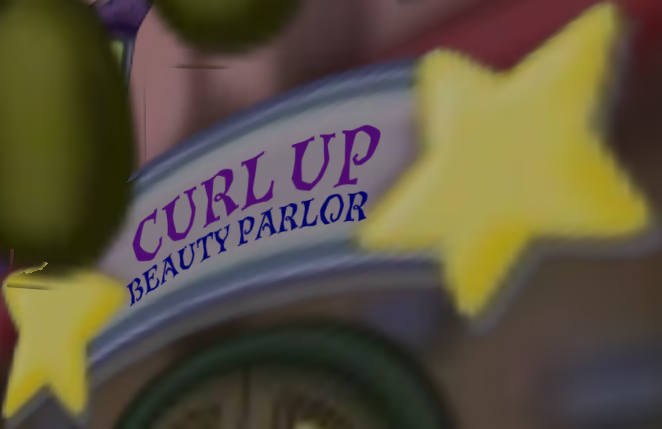
DDL is the final neighbourhood — & it’s no slouch, at that. It’s broken up into a whopping four (4) separate parts, of which this instalment will focus mostly on the first.
When it comes to the ToonTasks that make up these four parts, DDL is somewhat of a mixed bag. Part I only features written ToonTasks, part II is a roughly 50⧸50 mix of written Tasks & random ones, and parts III & IV are just random Tasks. However, this still accounts for a surprisingly large number of written Tasks, making the first two parts of DDL famously well-done, but also notoriously difficult — or even annoying, at times.
Speaking of annoying, the ToonTask to upgrade my jellybean jar to hold 150 beans had me visiting The Countess, who operates Counting Sheep — So You Don’t Have To! on Pajama Place:
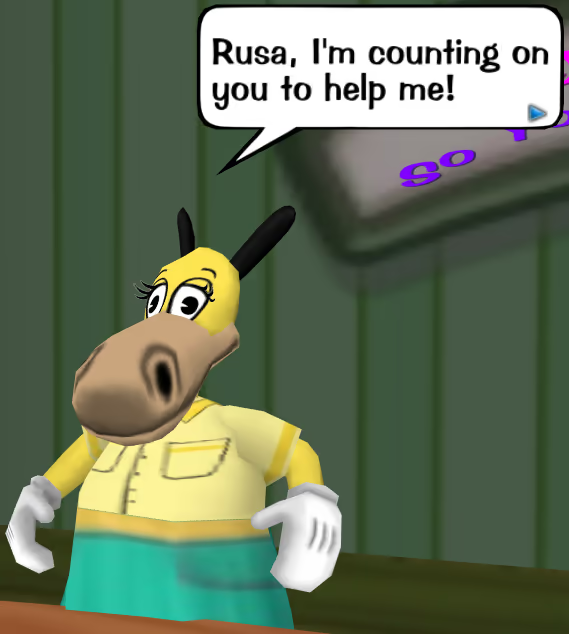
Countess is the feminine version of count as in the royal title, which is unrelated to the numeric sense, each originating from unrelated Anglo-Norman words. Coincidentally, both partially displaced native Germanic terms: the royal title is equivalent to earl (or from ON, jarl), whereas the numeric sense displaced what is now ModE tell, as in e.g. I can’t tell how many there are.
In any case, performing a repetitive & low-energy task in low-light conditions whilst laying in bed is a well-known recipe for falling asleep, & in English this is commonly counting sheep.
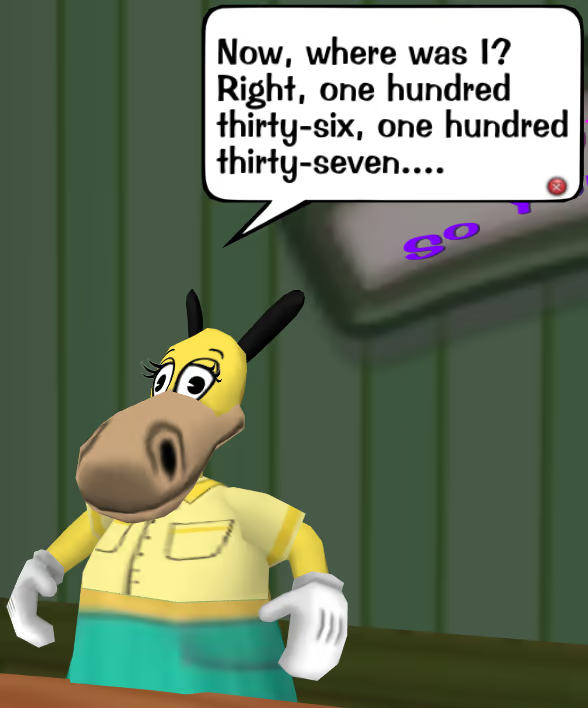
One hundred & thirty-seven being, of course, the value originally thought to be exactly equal to the reciprocal of the fine-structure constant. With more modern measurements, we now know that it’s more like ≈137.036, but where’s the magic in that?
The meat of this Task is actually just defeating 25 NoCos[1], which is the aforementioned annoying bit. Thankfully, I didn’t have to wait too long for a random NoCo Invasion to show up:
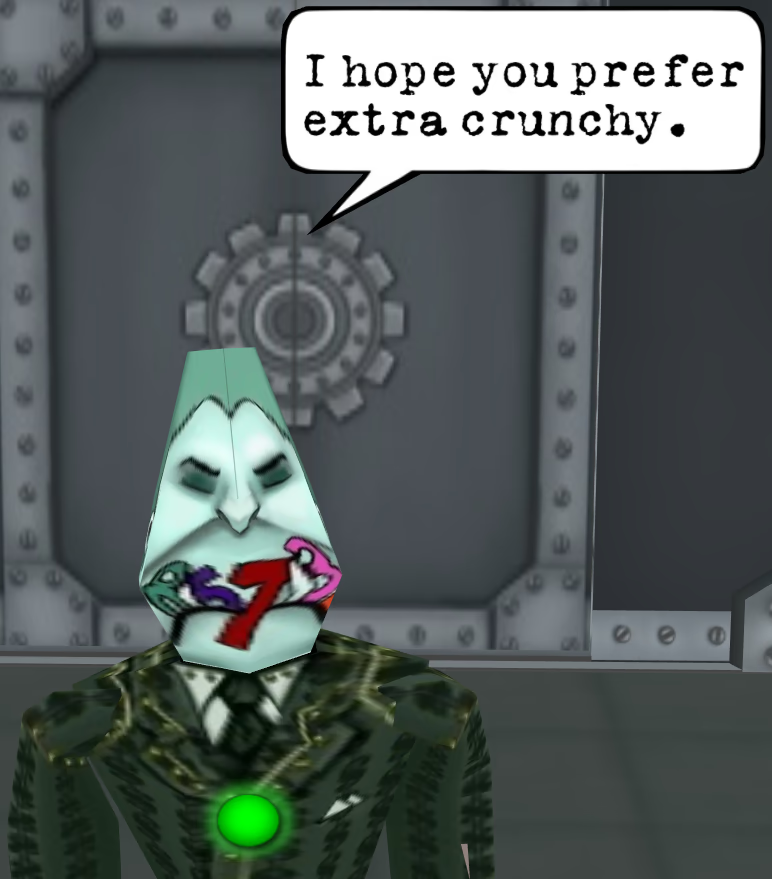
Mmm… Now I want a PB&J…
Footnotes for “Angels on the head of a pin”
- [↑] See the “It’s crunch time” section of the sixth instalment, for the origin of NoCo.
With one arm tied around my back

This isn’t related to any ToonTasks, but it’s time to follow up on something that I mentioned in the “[L’Internationale plays faintly]” section of the fourth instalment. By coming here to Talking In Your Sleep Voice Training, you can say — in SpeedChat — “Would you like some help?”, & this causes something very special to occur:
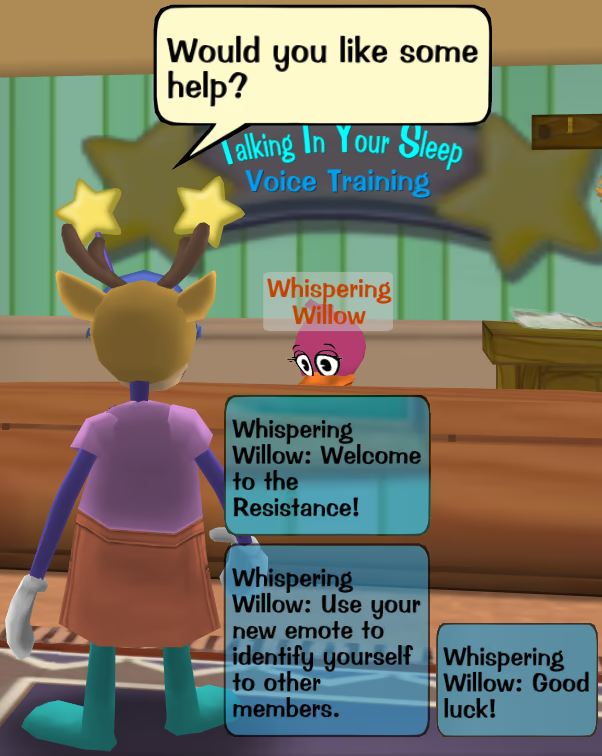
Transcription of the above image
Rusa [SpeedChat]: Would you like some help?
Whispering Willow [whisper]: Welcome to the Resistance!
Use your new emote to identify yourself to other members.
Good luck!
Whoa! I’m a member of The Resistance™ now!! The exact meaning of this phrase was only fleshed out somewhat later, when the Toon Resistance would come to be led by Lord Lowden Clear — who never appeared in 3D in TTO, but who was given a full in-game appearance in TTR. There’s a cast of other characters associated with the Toon Resistance, but I only know my gorl Whispering Willow.
The emote (Resistance Salute) is now permanently in my SpeedChat collection, & it looks something like this:
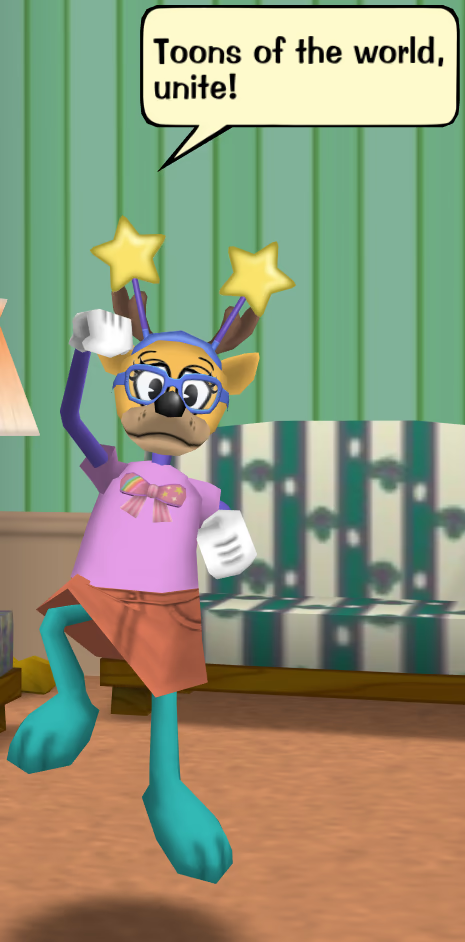
Sought & found

For a +3 maxlaff boost, I visited Rocco of Rock to Sleep Quarry on Lullaby Lane.
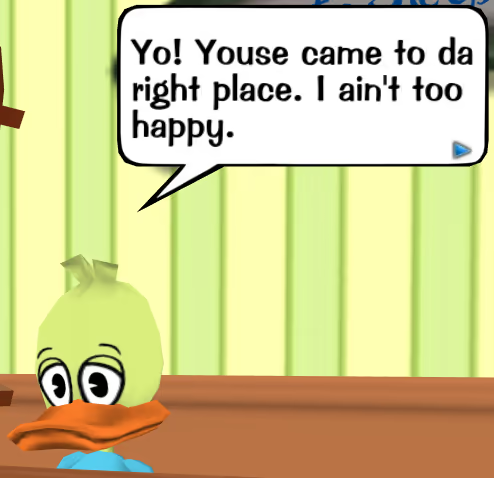
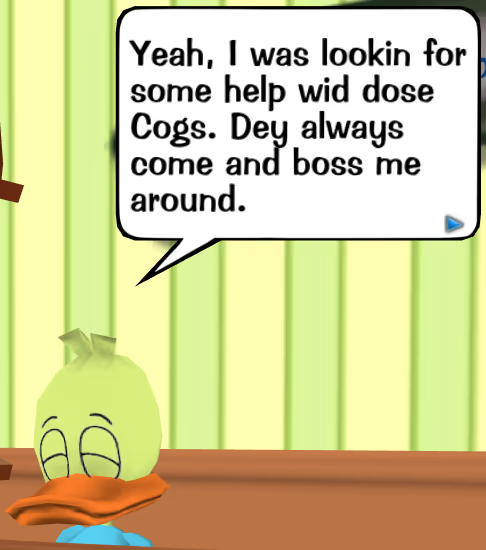
We have here another NPC speaking with (for the most part) pronunciation spellings to indicate that their speech is somehow nonstandard:
-
Yo in this sense (a greeting) is attested at least as far back as 1859, & is a cognate of High German jo/ja “yes, yeah” (amongst plenty of other cognates in other Germanic languages) via PGmc *ja. The Etymonline entry has this to say:
Modern popularity dates from World War II (when, it is said, it was a common response at roll calls) and seems to have been most intense in Philadelphia.
-
Youse (also ⟨yous, youz, youze⟩) is a common dialectal form of you, which may be singular, plural, or both, depending on the lect. Here, Rocco uses it in the singular, which the relevant Wiktionary entry claims is used in Philadelphia, New York City, Boston, & Cincinnati.
-
The spelling of (in this case, unstressed) the as ⟨da⟩ represents th-stopping[1]: /ðə/ [d̪ə] (or perhaps [də 〜 ɾə], losing the opposition between /ð/ and /d/). This also applies to with ⟨wid⟩, those ⟨dose⟩, they ⟨dey⟩. However, in the case of with, the sound in isolation would be /θ/ [t̪] and thus ⟨wit⟩, but here it assimilates with the immediately following /ð/.
-
Ain’t is a nonstandard contraction of, in this case, am not. The use of ain’t is restricted to working-class lects, for sociolinguistic reasons.
-
The spelling of looking as ⟨lookin⟩ (also ⟨lookin’⟩) represents so-called g-dropping: /ˈlʊ.kɪŋ/ [ˈlʊ.kɪn 〜 ˈlʊ.k(ə)n]. G-dropping is, however, a misnomer, as there is no /g/ — indeed, no sound whatsoever — that is being “dropped”. Rather, the voiced velar nasal, in certain positions, changes articulation to be alveolar instead. Like the use of ain’t, this is a working-class feature, but an even more widespread one.
However, we also notice that for is given the standard spelling ⟨for⟩ in spite of being immediately followed by some (which begins with an obvious consonant), suggesting that Rocco’s speech is rhotic. This eliminates New York City English as well as Northeastern New England English from consideration. This leaves Philadelphia English & Cincinnati English, with a bias towards the former due to the use of yo as a greeting. Moreover, as far as I can tell, Cincinnati speakers lack th-stopping.
This places Rocco as a white (no identifiable BAE features are present) working-class native of the Delaware Valley in the Northeastern U.S..
In any case, Rocco wants me to defeat Bossbots in DDL, which is also kind of a pain in the rump, on account of Lullaby Lane being the best street for Bossbots with only 25%. But it’s okay, I’m gonna go for a Cog Invasion anyway.
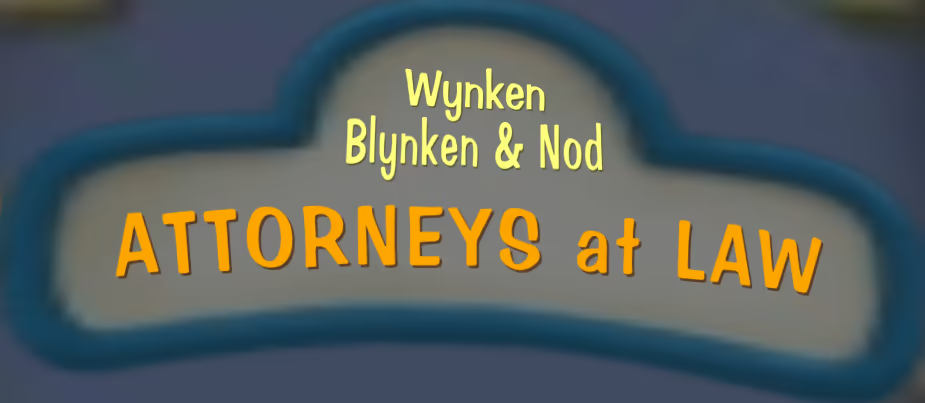
Wynken, Blynken, & Nod: Attorneys at Law on Pajama Place, operated by Lawful Linda. From the 1889 poem “Wynken, Blynken, and Nod” by Eugene Field. The first two names are presumably alterations of winking & blinking, respectively, & the poem’s final stanza contains the following text:
Wynken and Blynken are two little eyes,
and Nod is a little head,
And the wooden shoe that sailed the skies
is a wee one’s trundle-bed.
For a +2 maxlaff boost, I went to see Lawful Linda, who needed a whole laundry list of gadgets & gizmos only obtainable from certain Cog species. The first Task was to acquire “Rods” from Bean Counters — or as I like to call them, beanie bois:

Transcription of the above image
Five Story Bossbot Building
| district | location | Toons | last activity |
|---|---|---|---|
| Hiccup Hills | Pajama Place | 3 ⧸ 4 Toons | just now |
🗘 This group is synced in-game with TTR
| Toon | # in Party | Joined | ||
|---|---|---|---|---|
| name | maxlaff | gags | ||
| Rusa | 67 | Pixie Dust, TNT, Hypno-goggles (org), [Soundless], Birthday Cake, Geyser, Anvil | 1 | 4 mins ago |
| Mr. Coconut Gigglewiggle | 63 | Lipstick, [Trapless], [Lureless], Foghorn, Birthday Cake (org), Seltzer Bottle, Big Weight | 1 | just now |
| Metal | 63 | Bamboo Cane, [Trapless], $10 Bill, Elephant Trunk, Birthday Cake, Fire Hose, [Dropless] | 1 | just now |
🗪 Group chat
Rusa: hello gamers pls join me in busting beanie bois
So, yeah. If you were wondering what a ToonHQ group actually looks like, that’s basically it. The large majority of the time, I don’t start the groups myself — I prefer to wait for an enticing one to just show up. But, you know, sometimes the only way to get something done right is to do it yourself.
After a great deal of opportunistic Anvil usage, I unlocked the Big Weight (the level 4 Drop gag)!:
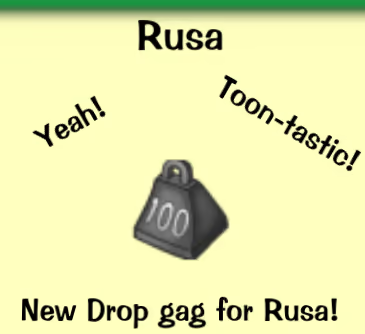
Wow! A Drop gag that’s actually of some use…! Fantastic. I think that means it’s time…
Footnotes for “Sought & found”
- [↑] Th-stopping already occurred long ago in many (if not most) Germanic languages, but English has managed to retain its dental fricatives in its standard varieties — if only by the skin of its teeth (har har).
Replant, supplant
…Specifically, time to tear out all of my Lure gag trees!!
![Rusa | Congratulations[,] you’ve earned a new watering can! Large Watering Can Rusa | Congratulations[,] you’ve earned a new watering can! Large Watering Can](https://deer.codeberg.page/tt_diary/008/rusa-large-watering-can.avif)
Oh… well, that’s nice.
In any case, this does mean giving up on some juicy organic Lure gags that I had just a minute ago. But it’s going to be worth it, I can feel it. In like a month, or however long it takes for these dang’d things to grow, I’ll have Super Drop…!

Minty fresh
Naturally, much like with DG & SBHQ, many of DDL’s ToonTasks deal with CBHQ. DDL Tasks are, after all, how the Cashbot Cog Disguise is obtained!
The ToonTask for the upper left leg part takes place between P.J. of P.J.’s Taxi Service (a play on the colloquial shortening of pyjamas as PJs) and Nat of Don’t Let The Bed Bugs Bite Exterminators (a play on the colloquial good night!; don’t let the bedbugs bite!). Much like the shopkeepers of DG, Nat & P.J. are not yet aware that there’s a full-blown Cog HQ on their very own street.
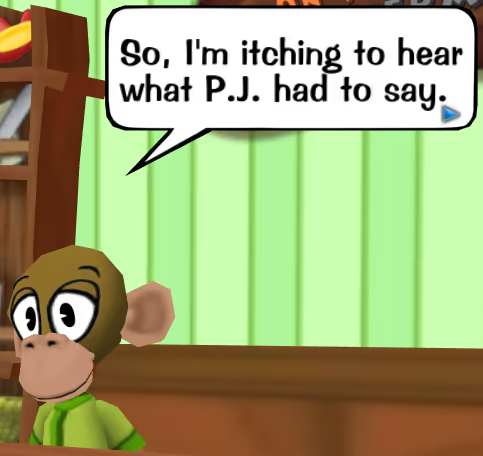
The English word gnat has no particular biological meaning (although Wiktionary identifies it with Diptera, ordinarily given the vulgar name fly), but is instead historically used for almost any small insect capable of flight that’s thought to be annoying. It is a reflex of PGmc *gnattaz /ˈɣnɑt.tɑz/ “a bite or scratch; a biting insect”, ultimately from a PIE source meaning “gnaw, bite; scratch, rub, grind”, also the source of English gnaw.
Bedbugs (the genus Cimex), then, are a kind of gnat (although their wings aren’t usable for flight), & the source of Nat’s itching. Gnaw & gnat, like other English words that begin with ⟨gn-⟩, have been cluster-reduced (this occurred sometime during the transition from EModE to ModE) to simply /n-/, & */gn-/ is no longer phonotactically valid. This makes gnat a homophone of Nat, a nickname for Nathan or similar.
Nat & P.J. wanted me to investigate CBHQ, & so investigate I did. Back in the “Biting off more than I can choose” section of the previous instalment, I made my unexpected first visit to CBHQ, & did my first post-UNM Mint with some other fresh newbs. This time, however, I made use of ToonHQ.
As expected, I got a different floor of the Coin Mint, & so saw some different rooms. Like this gallery of stacks on stacks of paper Cogbucks:

I’m very familiar with this room & its three fights. UNM has not only altered the Cogs found in those fights, but has also upgraded some of the textures. Neato.
Of course, just like last time, it’s a lot of mildly-watered-down Cog-fighting & the usual JQs etc., until the final fight featuring The Mint Auditor.
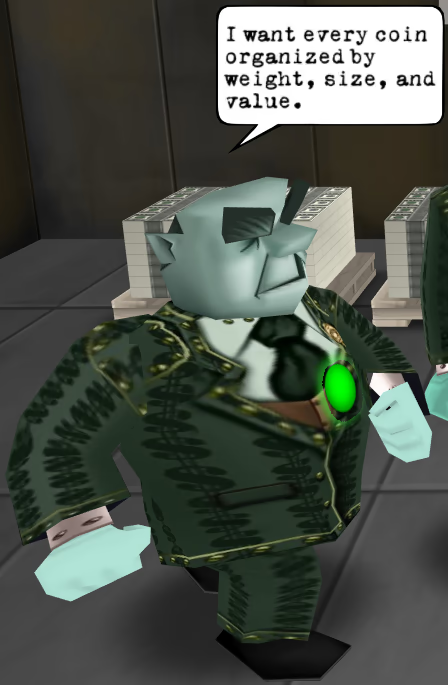
Unlike last time, however, we didn’t end up with a party of four all complaining about the tediousness of this final battle. I mean, yes, the fight seems to always feature the usual overcomplication of status-effect soup that makes the fight so different from… you know, the fights in the rest of the game, or those of TTO. But this time, The Mint Auditor pretty much immediately (i.e. within the first turn or two) decided to do something that I hadn’t previously seen:
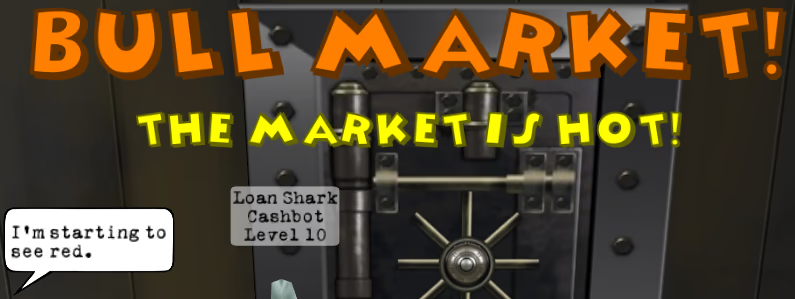
The use of Bull Market dispelled our Gag Tax & our Defence Up, & put a new status effect on all Toons in the battle:

The green boxing-glove effect (not sure what it’s actually called) basically means that everyone takes 25% extra damage, but also deals that much more damage. Needless to say, along with the game-changing removal of Gag Tax, this made the fight a lot more swift.
I spent most of this rather short Auditor fight attacking the Auditor with my Birthday Cake, etc., whilst the rest of my party pretty much just spammed Sound. By having Gag Tax removed almost immediately, & then using all Foghorns at once whilst the green boxing-glove was active, the fight was obliterated pretty quickly. At least, far more quickly than my first experience.
Still trying to understand…
ℹ️ Feel free to skip ahead to the “Putting the ‘funny’ in ‘funny money’” section below.
In the end, although it was perhaps nice to make the last fight so brief, I ended up with more questions than I started with. First of all, how do these supervisor Cogs even work? At first, I thought that they were like Cogs with special abilities, but they appear to be exempt from some of the game’s rules:
- Supervisors seem to vary arbitrarily in how many actions they’re allowed per round, with no clear indication of what they’re allowed to do in a particular round, nor of what they’re likely to do.
- Supervisors have no level associated with them, & thus no apparent amount of HP, along with no apparent values for
tgtDef, etc.. - Supervisors have a buff (& seem to be capable of bestowing such a buff on other Cogs) that makes them immune to Remote Controls & Pink Slips. Although I certainly understand the logic of making boss & miniboss Cogs (with supervisors being the latter) immune to these things so as to avoid trivialising the battle, it seems like no more than a half-measure. Moreover, applying this buff to perfectly ordinary (i.e. neither boss nor miniboss) Cogs seems backwards.
As regards the final item in the above list, if the idea is that powerful rewards[1] are capable of trivialising fights, then the bare minimum of consistency here is to actually overhaul Toontown’s reward[1] system. Presumably, the reason for not doing this is that it would necessarily be invasive.
But for starters, this invasion is of reward structure rather than the game’s fundamental core mechanics, the former of which I personally would consider a more acceptable invasion. Clearly, TTR’s priorities are the other way around, as demonstrated here. Moreover, it would seem wise to draw inspiration from the fact that fun & challenging runs in TTO & pre-v3.0.0 TTR have historically been rewardless, & often intentionally so[1]. Instead, the idea here seems to be to lean into the importance of rewards, & then to slap ad hoc exceptions onto that principle when it seems like it’s breaking the game “too much” (whatever that means).
Is it possible for a game to be in an arms race with itself?
And w.r.t. the first two items in the above list, I think that I’ve already covered (in previous instalments) my own critique of the general “vibe” that these things are a part of: hiding more information, leaning more heavily on random number generation, & perhaps most importantly, tacking on new game mechanics that further obfuscate & overcomplicate things — all these things in an attempt to bring life to a game that already had life inside of it, just waiting to be exposed to fresh air.
Putting the “funny” in “funny money”
The added inconsistency is, perhaps, not without its perks (& its quirks). Although the Cog battles leading up to the Auditor battle are now kind of a joke, I did find that my Coin Mint runs were significantly more varied from run to run than they would have been, pre-UNM.
Oh, & I unloque’d the mother-Flippying Juggling Cubes?!?:

Wow! Yeah! From here on out, my Toon-Up track will max itself…
Considering that this gag has always existed in the game (even going back to very early TTO), it’s perhaps surprising that I still, even to this day, wonder what it’s called. The original name is apparently Juggling Balls, as indicated by the relevant TTO Wiki article. However, that same article also mentions that it’s called Juggling Cubes on its trading card, & the TTR Wiki article calls them Juggling Cubes, in line with TTR’s current in-game name for them.
The series 1 trading card

Transcription of the above image
Juggling
Cubes
© 2004 Disney
www.toontown.com

Transcription of the above image
You’ll have your hands full with these jazzy juggling jewels! Even jealous jerks become jolly juggling jesters with Jeff & Jesse’s Jocular Juggling Cubes! Filled with Mexican Juggling Beans, they’re easy to pick up and hard to put down. Remember, juggling is catching, so Toon-Up today with Jeff & Jesse’s Jocular Juggling Cubes — always good to the last drop!
[Goofy’s Gag Shop logo]
| Toons up: | All Toons |
|---|---|
| Skill Points | 6 |
| Base Accuracy | 70% |
| Laff Points | 90–120 |
Goofy’s tip: Tooning-up a Toon with a full Laff meter will not earn any skill points.
1
Toon-Up track
[TTO logo]
Being a TTO veteran myself, I always thought of them as Juggling Balls. But, you know, try getting that through the SpeedChat+ filter! As of this writing, ball is permitted by TTR’s filter, but *balls is not, & the obvious workaround of *ball 's is likewise blacklisted. Plus, the in-game mesh for each “ball” is pretty clearly a cube, not a ball.
Wait… did I just say blacklisted? Oh, yes. The SpeedChat+ filter is primarily a whitelist-based system, but it has a secondary blacklist filter that it passes through as well. My least favourite part of this feature is that it’s the most likely to unexpectedly censor entire chunks of perfectly good English that are also innocent — & thus “should” pass through the filter untouched.
I frequently forget this when I say e.g. I’ll take that as a yes (or […] as a no), which ends up as I’ll take vveh a yes. Really?? Is the rather likely & semantically neutral (a determiner & a preposition, respectively) collocation that as really too similar to that ass[2] that we can’t bear the sight of such sentence constructions? 😤
Anyway, Language Crimes™ aside… where was I? Oh, right. My Coin Mint experiences were a mixed bag for sure. In this run, we were collectively having a hard enough time actually picking & sticking to a strategy that Conor felt the need to summon the aid of Nancy Gas:
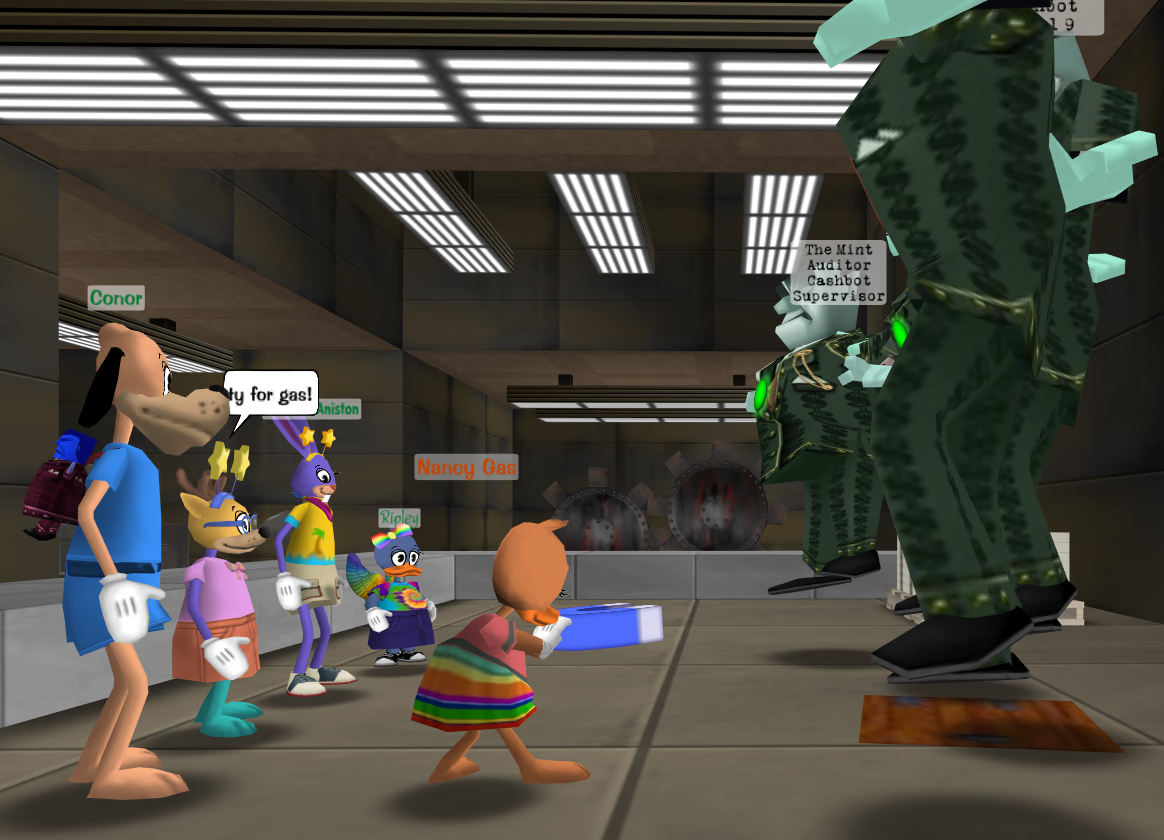
Is it really necessary? I mean, no. But the fact is that Lure SOS Toons cannot miss, which is more than I can say for ordinary Lure gags, especially post-v4.0.0!
And make no mistake, the green boxing-glove can be a hazard.

Pain is the perfect word for this situation: I just got punched in the face, it hurts, and I’m rather hungry. 🥖
Don’t worry, though; I survived. And I maxed my Throw track?!?:

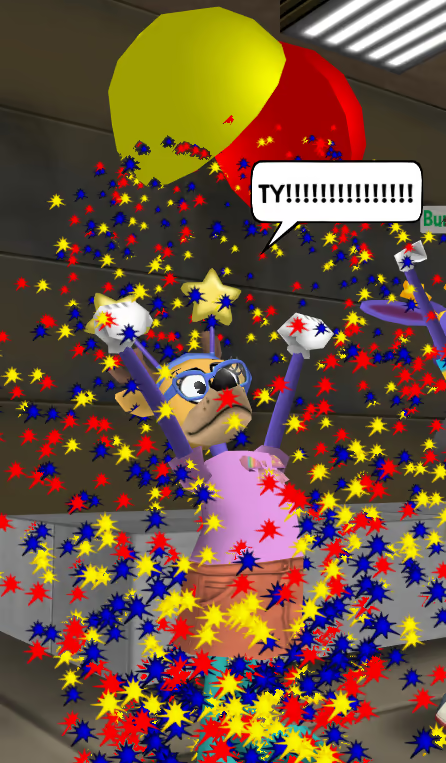
Pretty cool.
Speaking of pretty cool, in another Coin Mint run, I got my first exposure to a brand-new room added to Mints by UNM:
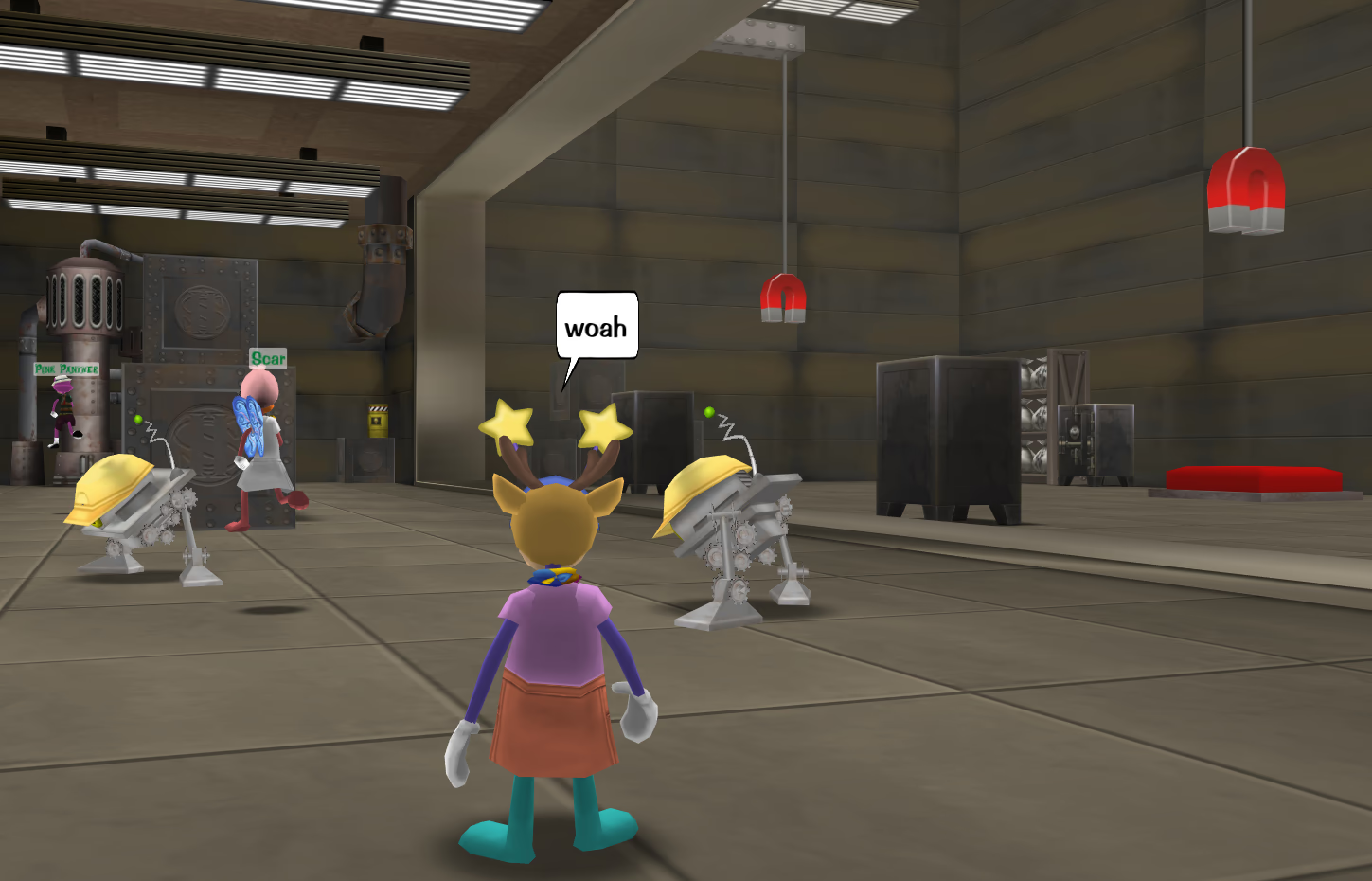
But wherefore? Well, this new room brings a new minigame with it: the Crane Game! The idea is basically to prepare players for the C.F.O. fight by familiarising them with the crane mechanics, which admittedly can be a bit wacky if you’ve never used a crane before.
Rusa will hopefully get to do C.F.O. runs herself in the future, but for now, we just need to know what a crane is. The crane can be moved — somewhat slowly, & in a rather clunky manner — in any of the usual eight cardinal & ordinal directions. The end of said crane has a flexible cable attaching it to a big red magnet that can be powered on & off at will. When powered on, the magnet can grab up to one (1) nearby safe at a time. This is really physics-heavy, so picking up safes & then chucking them in the desired way can actually be quite tricky!
For the Crane Game, the object is simply to press a big red button with one of the provided safes. This turns it green, & opens the way further into the Mint.
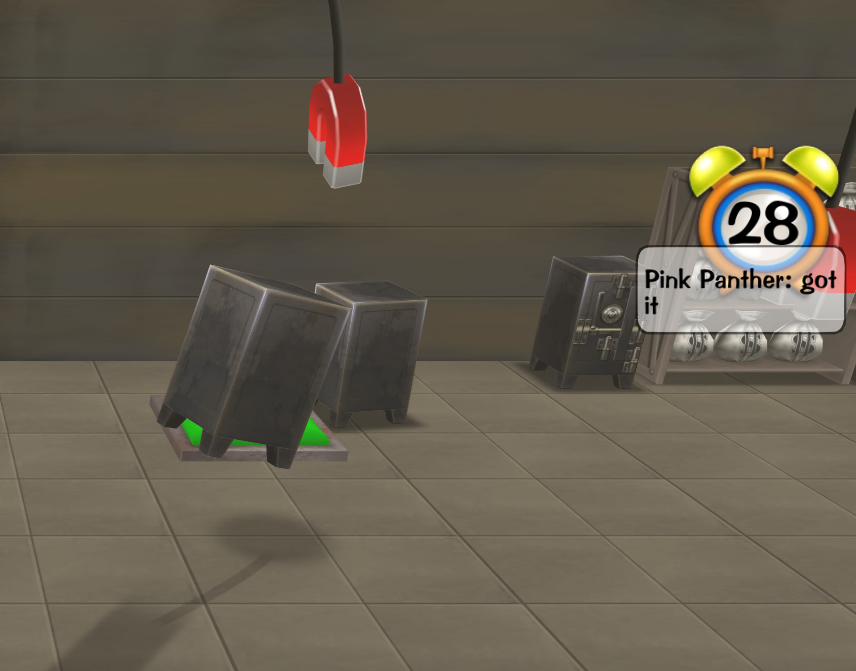
To be honest, I didn’t get the chance to have much fun with the crane, as Pink Panther “got it” very quickly.
Rusa also got her first exposure to Stomper Alley. Although this room isn’t quite new to Mints, it does seem to’ve been slightly retouched, not just in its textures, but also in the selection of laff & gag barrels. Basically, almost the entirety of Stomper Alley is covered by active stompers that sting quite a bit if you’re stomped by one. The only way to avoid getting stomped is to be in one of the little cubbyholes in the ground, where the stompers can’t reach:

By carefully moving from one cubbyhole to another whilst the stompers are winding up for another stomp, it’s possible to traverse Stomper Alley unscathed. It’s also an important source of laff barrels & gag restock barrels.
Footnotes for “Minty fresh”
- [↑] See footnote #2 of the “It happened.” section of the fifth instalment.
- [↑] *That arse? I doubt it. I feel like this phrase is an Americanism. And, speaking of th-stopping, the more common form seems to be dat ass.
Zed, or zee, or whatever it might be

For the most part, however, I avoided Tasks that required going to CBHQ. It’s not that I absolutely don’t want to do Mints; indeed, even when I got easy CBHQ Tasks that could be done without Minting, I Minted anyway. But I wanted to continue doing Cog Buildings for the most part, rather than spreading myself across two regions of the game, when one of them isn’t really designed for gag XP grinding (not that Mints are bad for it, by any means), & especially considering that Mints are unlike Factories in that they don’t directly award Cog Disguise parts.
That brings me to a very special ToonTask. This Task is one of just three Tasks in the game (all of which are in DDL) that awards a maxlaff boost of more than +3, & is the only one that isn’t a random ToonTask! For this Task, I paid a visit to House of Zzzzzs on Pajama Place, to meet with Zari:
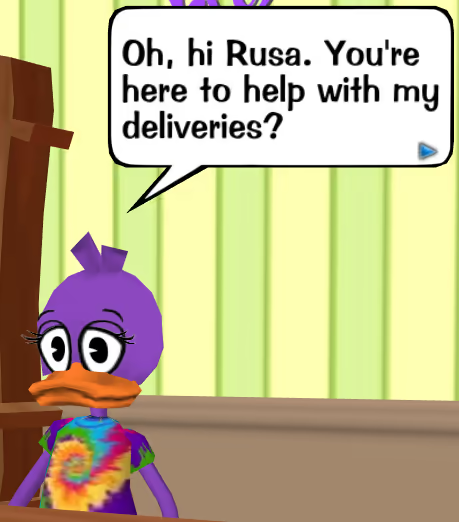

Befitting its awesome reward, this Task is rather elaborate. Much of it is exactly as stated: delivering various items to various shopkeepers in DDL. The catch is that, in addition to delivery service, some Cogs need defeating as well. But actually, there’s another catch: everything starts with a ⟨z⟩.
In English, zzz (also ⟨zzzz, zzzzz, …⟩) is the conventional onomatopœia for sleep, apparently indicating some kind of snoring noise. Although I suppose it’s probably(?) pronounced as the speaker’s best imitation of snoring, the specific choice of the letter ⟨z⟩ is nevertheless very conventional & widespread. There’s an emoji for it ⟨💤⟩, Toontown uses . . . ZZZ . . . as the thought-bubble text for sleeping Toons, & there’s even the phrase [to] catch some z’s meaning “[to] sleep”.
Of course, there’s the question of how to pronounce Z. The usual pronunciation is /zɛd/, but some lects (especially in North America) use /ziː/, & I just learnt that there’s a now-archaic dialectal pronunciation /ˈɪ.zə(ɹ)d/ (apparently of Romance origin)!
For better or worse, ⟨z⟩ is not a particularly common letter in the English language. To the immense chagrin of any ⟨z⟩-lovers, its usual role in pronunciation is very frequently taken up by its arch nemesis, the letter ⟨s⟩, often for morphophonological reasons (as in e.g. eyes /aɪ̯z/) — but also because OE historically didn’t use this letter. As a result of this, & of the fact that English just didn’t inherit all that many words that begin with /z-/, finding English words that start with this letter can be very difficult indeed.
But Zari is in the business of z’s; it’s her whole thing. So these are the products that I delivered:
- zither
-
A musical instrument, now most commonly referring specifically to H–S 314.122 “True board zither with resonator box (box zither)”. But H–S refers to all instruments of classification 31 as “simple chordophones (zithers)”, which contrasts them with other H–S 3 instruments (“chordophones”), which have more than just a string-bearer (e.g. a resonator) & are thus not “simple” in this sense.
The ⟨z⟩ in zither comes to us from High German Zither /ˈt͡sɪ.tɐ/, ultimately from Ancient Greek κιθάρᾱ ⟨kithárā⟩ (which is not a reflex of any known PIE roots; Wiktionary suggests a Hurro-Urartian origin). This makes it a doublet of guitar. As indicated by the spelling with ⟨κ-⟩, this was originally /k-/, but was palatalised under the influence of the following ⟨ι⟩ > ⟨i⟩ during its trip through Latin, resulting in the High German /t͡s-/ ⟨Z⟩. The English pronunciation is presumably influenced by the spelling.
- Zamboni™
- A genericised trademark for a brand of ice resurfacers (1957), named for Frank Joseph Zamboni Jr.. The name is Italian, so originally /d͡z-/. Probably from a variant of Gianni /d͡ʒ-/, equivalent to English Johnny.
- zebra zabuton
-
A zabuton is a traditional Japanese cushion for sitting. 座布団 /zä.bɯ̟ᵝꜜto̞N/ [d͡zä.bɯ̟ᵝꜜtõ̞ɴ]. Doublet of futon.
Zebra here presumably indicates a striped pattern. The term is borrowed from Italian, ultimately from Latin equiferus “wild horse” via Galician–Portuguese. The word presumably underwent apheresis whilst also palatalising the original /kʷ-/.
- Zinnia
- A genus of sunflowers (in Asteraceae), native to the region between the southwestern U.S. & much of South America. Named for German botanist Johann Gottfried Zinn. Zinn /t͡sɪn/ means “tin” (& thus also a surname for a tinworker), from PGmc *tiną /ˈti.nɑ̃/ “tin”, hence a cognate of English tin.
- zydeco records
-
Music genre originated by Creoles of colour in Southwest Louisiana during the early 20th c.. Influenced by Cajun music and R&B. Prominently features the accordion and a special type of washboard worn over the shoulders.
The origins of the term zydeco /ˈzaɪ̯.dɪˌkoʊ̯/ are unclear, but it presumably entered English from Louisiana French through Louisiana Creole. It was perhaps from zarico, with the intervocalic /-r-/ [-ɾ-] mistaken for English /-d-/ [-ɾ-] due to alveolar flapping. Zarico is itself a rebracketing of les haricots “green beans”.
- zucchini
- The edible fruit of a cultivar of Cucurbita pepo ssp. pepo. Italian zucca “marrow, squash” > diminutive zucchino > plural zucchini, all /d͡z-/. English does not use the singular form, so the plural in English is zucchinis. From Latin cucurbita, of unknown origin.
- zoot suit
-
A men’s suit, originally worn by Black Americans, fashionable from the 1920s to early 1940s. Later associated with Mexican Americans, especially due to the Zoot Suit Riots.
The term is probably from BAE as a reduplication of suit. Zoot is sometimes ⟨zuit⟩ for this reason. Suit is via Anglo-Norman suite, from Latin sequor “[to] follow; [to] attend, accompany” (cf. Spanish/Portuguese seguir).
- zircon cufflinks
-
Zircon is a nesosilicate mineral with the chemical formula ZrSiO4.
PIE *ǵʰelh₃- “[to] flourish, shine; green, yellow” > … > Parthian *𐭆𐭓𐭍- *⟨zarn-⟩ “gold” > Middle Persian 𐭦𐭫𐭢𐭥𐭭 ⟨zargōn⟩ /zɐrˈgo̞ːn/ “gold-coloured” > Arabic زَرْقُون ⟨zarqūn⟩ /zarˈquːn/ “red lead; zircon”. Entered English via High German. A very distant doublet of gold, yellow, & gall! Incredible.
Wiktionary traces this word to Ancient Greek συρικόν ⟨syrikón⟩ /sy.ri.kón/ “red lead (lit. Syrian lead)”, but the connexion is unclear to me.
The zircon cufflinks are not actually delivered over the course of the ToonTask, but are mentioned as the final delivery to Babyface MacDougal.
Perhaps unsurprisingly, of these eight items, only two of them (viz. Zinnia & zoot suit) are of Germanic origin, & even then, zoot suit is debatable insofar as the recent /s-/ → /z-/ alteration is the only “Germanic” part!
In any case, I’ve still yet to complete Rocco’s Task, so I started doing Bossbot Buildings in uninvaded districts. It was here where I encountered a rather bizarre Cog-related glitch for the first time:
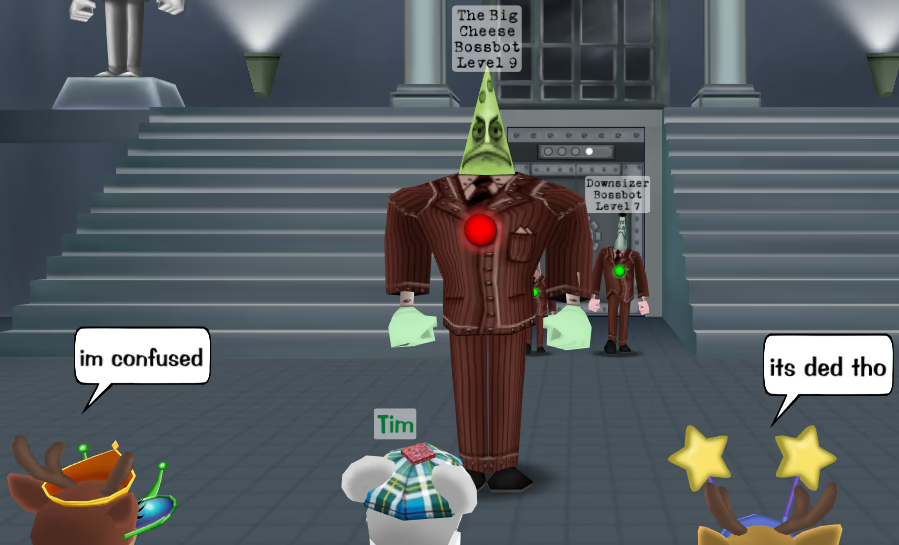
Transcription of the chatbubbles in the above image
[brown deer]: im confused
Rusa: its ded tho
We had very clearly lowered this Big Cheese’s HP to ≤0, but it just kinda… stood there? Thankfully, the glitch seems to instantly magically resolve itself as soon as the next round actually starts. There was no Cog death animation, it just went poof!
Speaking of faulty logic, I had some very brave & outspoken Toons in one of my Cog Building runs commenting on my character build…:

Transcription of the chatbubbles in the above image
[Toon A]: soundless being the hardest imo
[Toon B]: no sound just makes things slower
If I’m being honest, I’m not particularly likely to be commenting upon such comments, & I generally don’t say anything unless directly interrogated — & even then, I frequently don’t have much to say in direct response[1]. That being said, I’m always reminded of a certain Toon’s insistence that the usual claims that “Soundless Toons make things slower” are little more than drivel.
Historically, the origin of these claims — the actual logic that lies behind them — has been that Soundless situations & the accompanying “mixed strategies” (as I like to call them) are so infrequently encountered that noöne learns how to play them. Nowadays, we call this a skill issue: if you think that Soundlessness “just makes things slower”, it’s only because you’re bad at Toontown. That’s fine, but maybe don’t go pointing fingers next time.
I understand that old habits die hard. But my surprise at seeing these endlessly recycled comments has nevertheless increased ever-so-slightly, as of TTR v4.0.0. That sneaky little decrease of Foghorn capacity from 3 to 2 was perhaps too sneaky — or, you know, just didn’t really change the fundamental operation of Sound, as I’ve noted previously. Give it some time, maybe…
Speaking of character build choices that elicit flustered commentary, I did a Cog Building with a certain Unidentified Barking Object[2]:
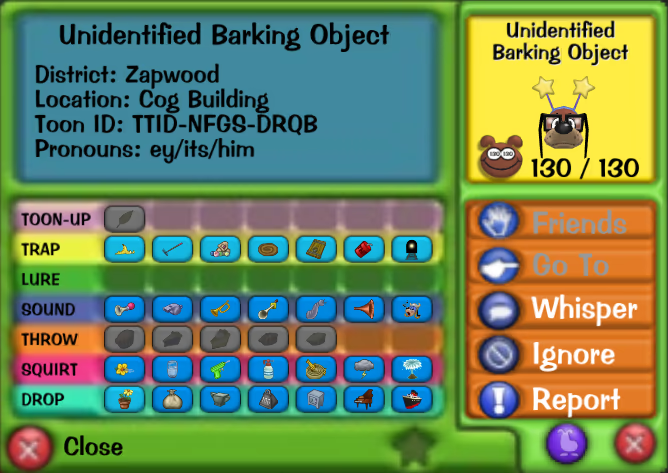
Unidentified Barking Object is a semi[3], basically meaning that he has fewer gag tracks than would otherwise be expected of him. In particular, he has definitely progressed beyond The Brrrgh’s Taskline (as evidenced by his 130 maxlaff, amongst other things), from which we would expect six gag tracks; yet, he has only four: org Trap, Sound, Squirt, & Drop. He is thus Toon-Upless, Lureless, and Throwless.
Perhaps the most characteristic part of this build is the Throwlessness. Although giving him Throw would still result in a semi build, being Toon-Upless is not considered particularly unusual amongst ordinary (read: non-Über non-semi)[3] builds, & neither is being Lureless. On the other hand, Throw is considered an important track for certain kinds of game content, & in any case, being Throwless implies being a semi; this latter property is shared only with Squirtlessness.
And, as long as we’re peeping random Toons’ info windows, I came across this Toon named Miñin Rabbit:
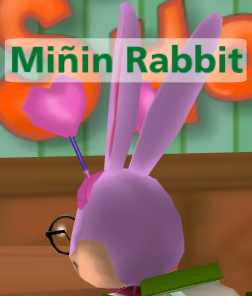
The very beginning of Rusa’s journey was back in the “Revisitation” section of the first instalment. The first thing that I encountered was a Toon with a name (viz. Màrmelàde) containing unexpected non-ASCII characters, support for which must’ve been added to TTR whilst I was away.
Much like in the case of Màrmelàde, however, I can’t figure out what the diacritics are supposed to be doing here. The letter ⟨ñ⟩ is from Spanish, to be sure, although it has since been used for various other languages. It usually represents /ɲ/, which is a little like the ⟨n⟩ in English canyon — but English doesn’t actually use this sound (at least, not phonemically). But, erm… what’s a *miñin? I can only come up with two guesses:
- It’s an obscure surname, presumably of Spanish(??) origin.
- It’s a fanciful spelling of English minion /ˈmɪn.jən/, with the ⟨ñ⟩ representing /-nj-/, & the second ⟨i⟩ representing /ɪ 〜 ə/ due to the influence of the weak vowel merger.
Hmmm……
Well, it’s time to work on Zari’s Task. I need to destructificate some Cashbots, so a Building in a NoCo Invasion oughta do the trick. Plus, the Task for the lower right leg requires thirty of these crunchy bois!!
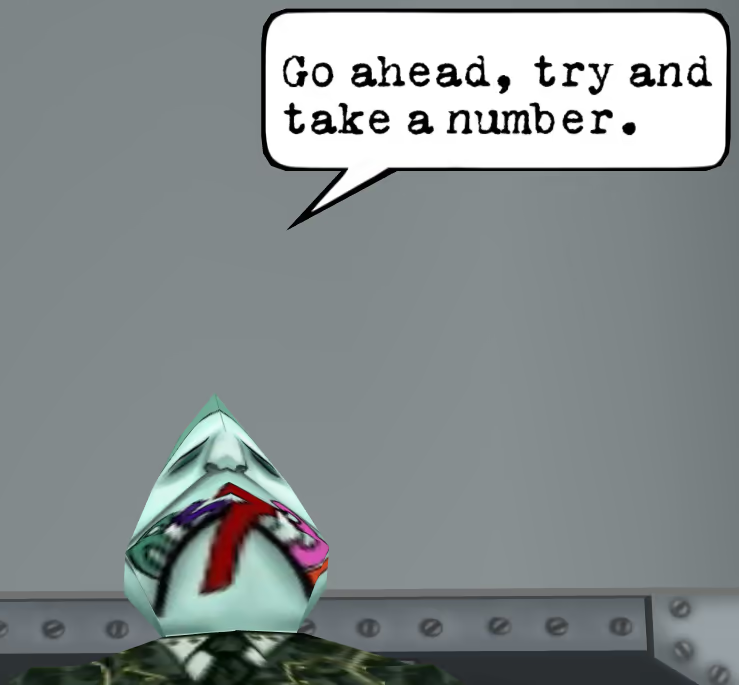
Style guides (& various other prescriptivists) will try & tell you[4] that this construction is incorrect or otherwise substandard, but I’m here to tell you that they’re wrong.
The ordinary construction is try to take, where try is a catenative verb[5] that subordinates the verb take. Because it’s subordinated, take takes on its infinitive form, & in this case must be the full infinitive to take, because try requires it (consider the ungrammatical *try take).
However, by hendiadys, this transforms into try and take; compare the similar come and get it in place of come get it. The direct grammatical analysis sees the try in this case as its non-catenative sense, thus making this conjunction (viz. and) still technically grammatical; consider Why don’t you try? Take a number!. But really, this is just hendiadys, which is otherwise (in English) thought of as a literary effect. Perhaps one of the most famous examples is in The Tragedie of Macbeth (act V, scene v):
Life’s but a vvalking Shadouu, a poore Player,
That ſtruts and frets his houre vpon the Stage,
And then is heard no more. It is a Tale
Told by an Ideot, full of ſound and fury
Signifying nothing.
Compare the less effective furious sound, where furious is subordinated (albeit as an adjective, rather than a verb) to sound.
Anyway, with that done, I moved on to the next part of this ToonTask…:
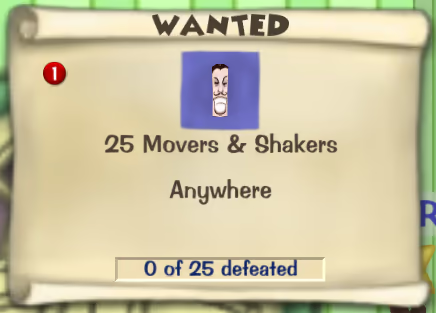
25! Of specifically Movers & Shakers!! Yeah… I’m not doing this without an Invasion.

Alright, that’s enough moving, enough shaking, & enough delivering! Gimme my maxlaffs!!
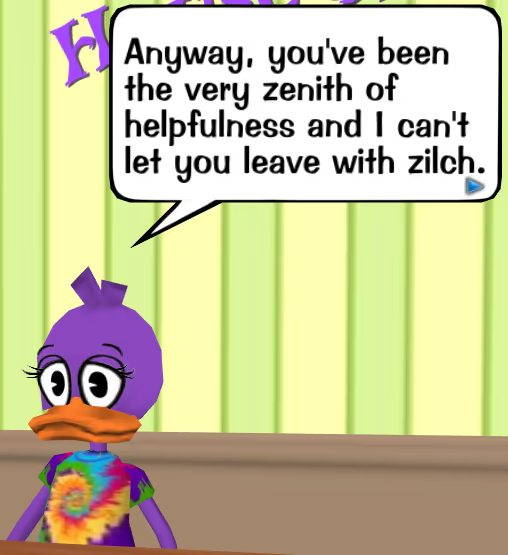
Thankee. ☺️
And hopefully Ed of Ed’s Red Bed Spreads will be pleased with my thirty NoCo takedowns, even if he’s more than a little displeased with Honey Moon’s request for a blue bedspread…

I know, right? Blue? Ridiculous. That doesn’t rhyme at all!
Footnotes for “Zed, or zee, or whatever it might be”
- [↑] Heaven forfend I come off as curt. I just don’t ever get insightful questions, so there’s not much that I can say — at least, not within the confines of a brief SpeedChat+ exchange…
- [↑] Not quite as good as Unidentified Feline Object, if you ask me. Then again, that would require actually playing a cat Toon…
- [↑] Please see footnote #5 of the “Factorial” section of the fourth instalment, for a more thorough discussion.
- [↑] Hah!
- [↑] Catenative verb constructions in English are often likened to the serial verb constructions of Sinitic languages. However, the “construction” in serial verb construction is misleading, as it doesn’t actually refer to any particular construction. It’s just a general term for any construction — no matter how disparate! — where two or more verbs end up appearing contiguously at the surface level. See Waltraud Paul’s The serial verb construction in Chinese: A tenacious myth & a Gordian knot (2008).
I’m on a boat
That’s a whole lot of business, though. I think I could do with a little partying for a change of pace. Someone started a beanfest in the decidedly unusual location of the DDock boat:
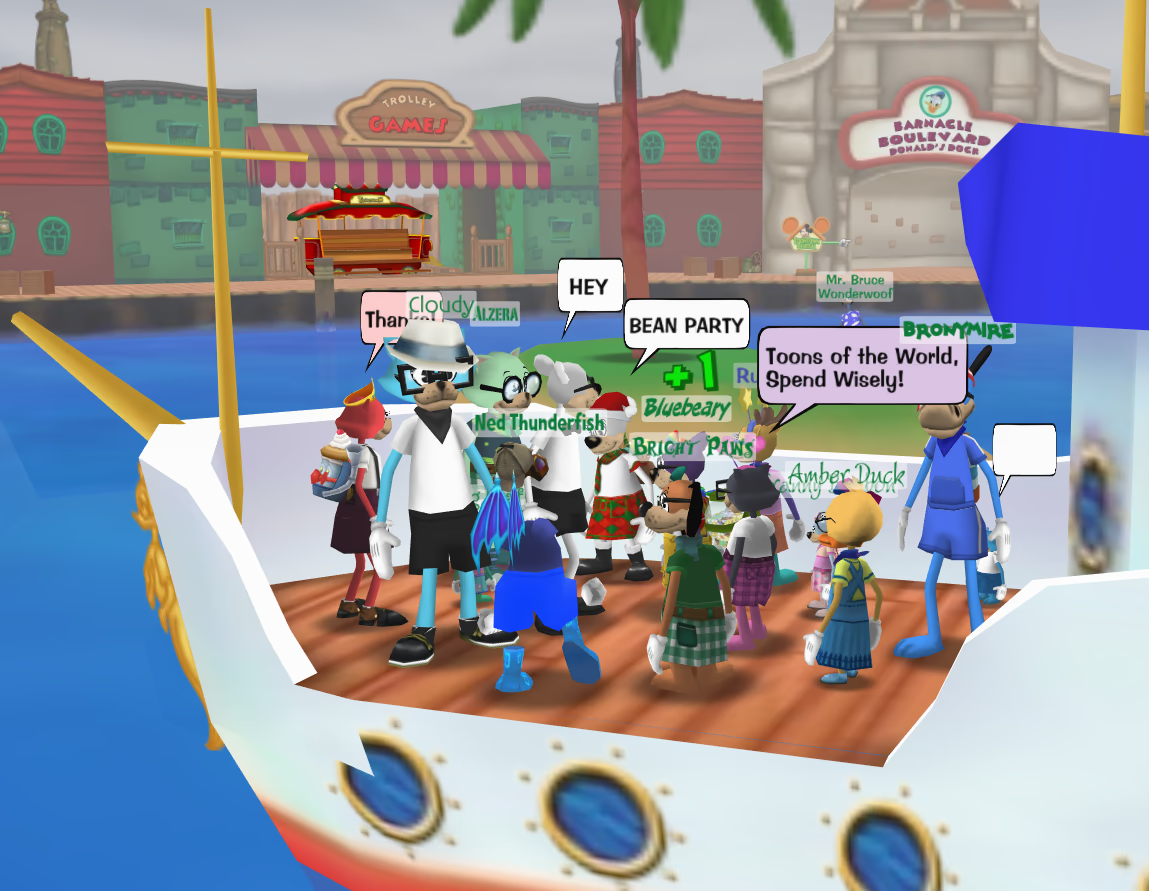
Yep! It’s a bit crowded, but this boat autonomously rides around the DDock playground 24⧸7. Who would start a beanfest on the DDock boat, though? As it turned out, ’twas none other than Icébéar:

Oh, my lord. Yet another name making use of the non-ASCII characters just to make English names look… fancy? What is this, Spın̈al Tap??
Honestly, now I want to make a new Toon just to prove that these newfound Latin diacritical powers can be used for good.
Someone whom I recently met on TTR told me that she was thinking of changing her name to حَبِيبَتِي /ħäˈbiː.bä.tiː/ (she’s a Palestinian Arabic speaker, I think). Now, obviously, using a whole other writing system beyond the Latin alphabet is gonna be too much for TTR. So the idea is to Romanise it. I’m just hoping that she takes my advice & at least attempts ⟨Ḥabībatī⟩ (or *⟨Habībatī⟩, at the very least), rather than the more obvious — but much less accurate! — *⟨Habibati⟩. This word is, by the way, borrowed into English, but only in the masculine form (used for any gender, in English): habibi “darling, beloved”.
Crepuscular estate
Well, now that I’m all full up on jellybeans, I s’pose it’s time to buy stuff!
I learnt that you can now buy skies for your estate. Yes, you can purchase the whole friccin’ sky. So naturally, I bought one to make it permanently nighttime:
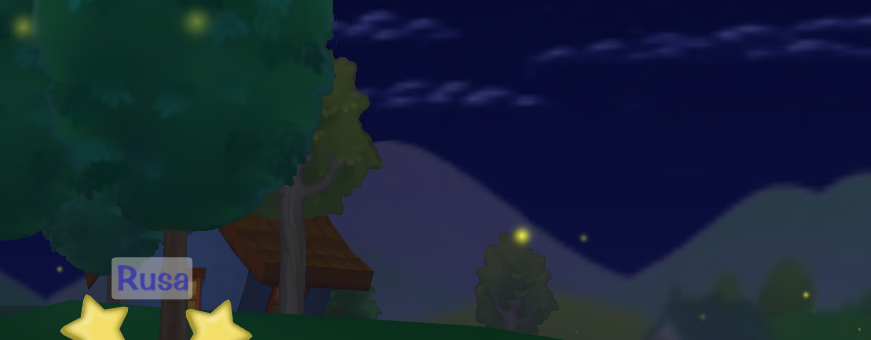
See those little yellow glows? I count ten of them in the above image, I think. They’re fireflies (a.k.a. lightning bugs), of the family Lampyridae, so called for their eye-catching bioluminescence. I mean, they’re not real fireflies, but they are rendered in 3D space here. No two-dimensional overlays; you get perfectly good parallax when moving around!
My eyes certainly thank me for these 5k beans well spent. It’s peacefully quiet, as well. And I get this rather smug-looking moon in the sky:

A little creepy, but it’s a small price to pay. I like how the houses glow from inside:
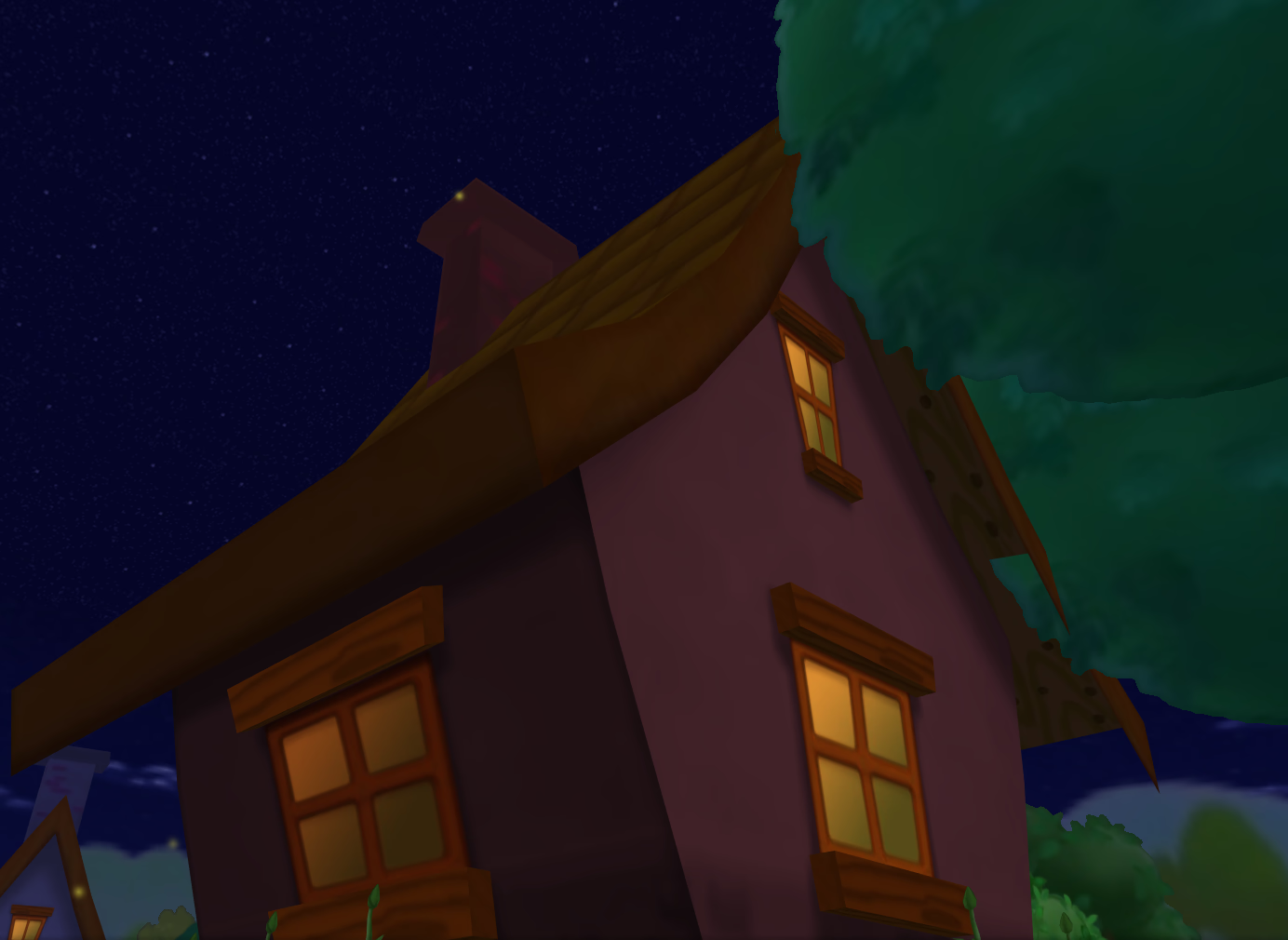
Maybe the effect is better at a distance. Unfortunately, I’ve yet to get any good house exteriors in my Cattlelog so far.
But what about the interior? Well, I bought some things, although I’m not terribly thrilled about any of them. The pink-&-purple bed is nice.
In any case, I thought that this would be a good time to mess around with the OOB of my house. I managed to very carefully place my wardrobe so that only the doors peek through the wall:
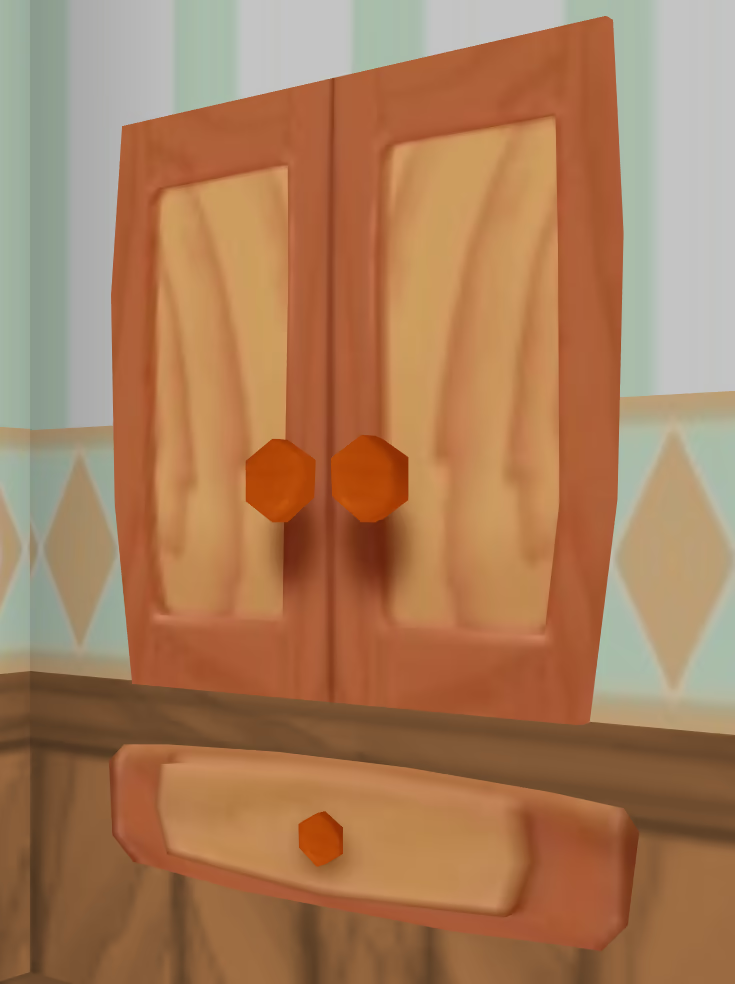
It’s not a bad look, I think. It’s space-efficient, & the wardrobe still otherwise works normally. But I think I have a better idea about how to use the wardrobe…
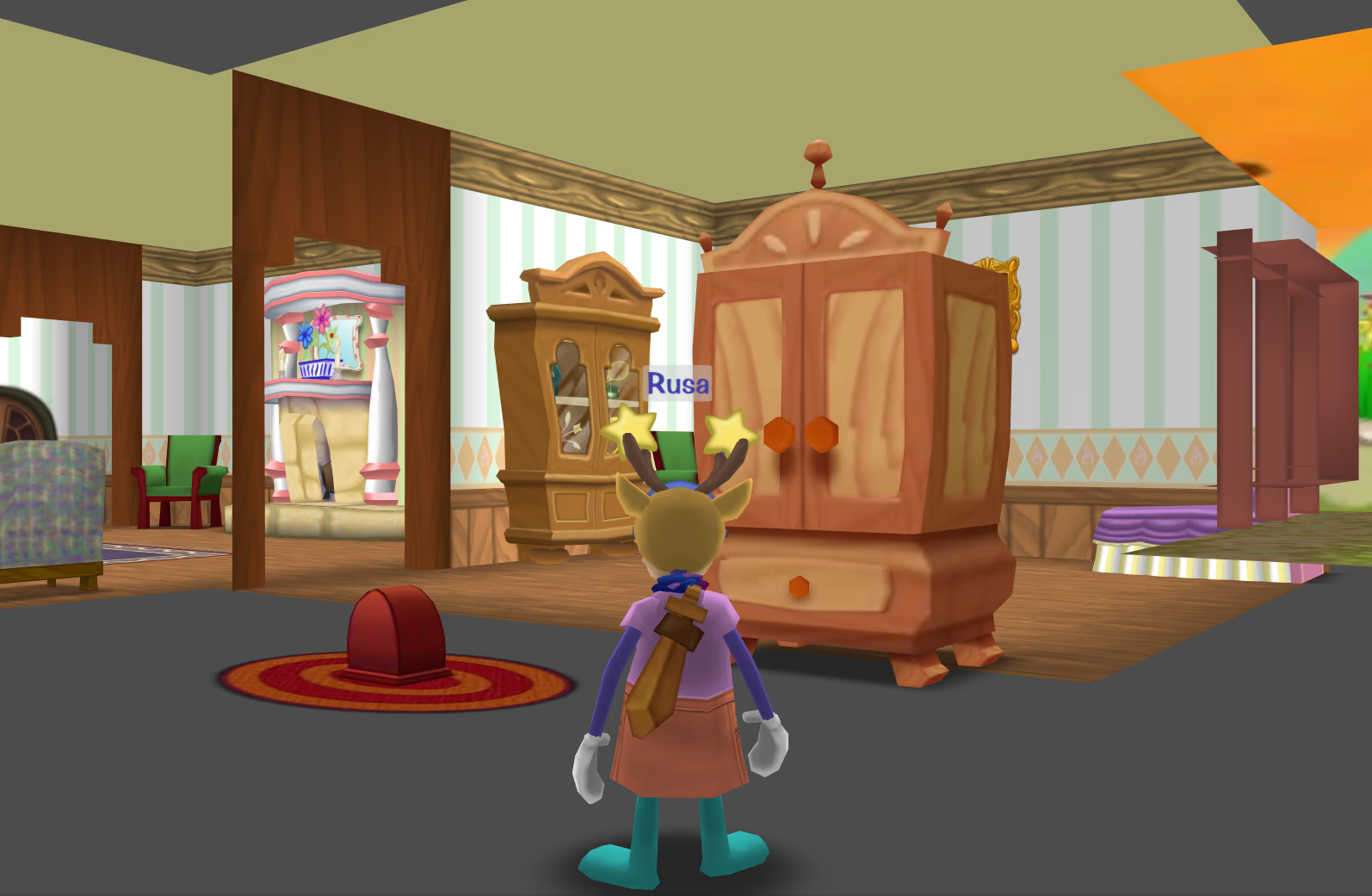
By positioning my wardrobe facing out of my house, putting it halfway through the wall, & then walking into the back of it, I can purposely move OOB. Not bad, right? OOB is traditionally known as the grey, for its grey colour — although it seems to randomly turn green these days. Not sure why.
The grey is functionally infinite in extent. In reality, there are presumably some numeric precision limits that make it technically finite, but it doesn’t really matter. This is about as far as I can go before my house’s interior is outside the draw distance:
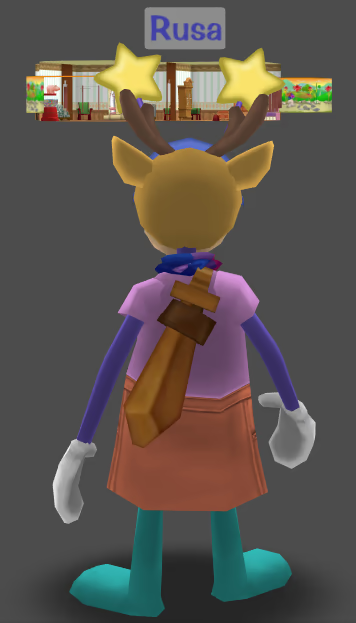
They grey is undoubtedly bleak, & looking back towards the interior gives a glitchy view of it that’s not quite as beautiful as the intended perspective. Nonetheless, the grey’s unlimited space contrasts favourably with the cramped interior, so “building out” into the grey gives a lot more freedom. I’ll have to try it soon.
But I think that’s enough for now. I’m glad that it’s now nighttime all the time, because I am heckin’ tired all the time. Time to try out my new bed… 💤
Sunday funnies
Funny papers (crossword puzzle not included)
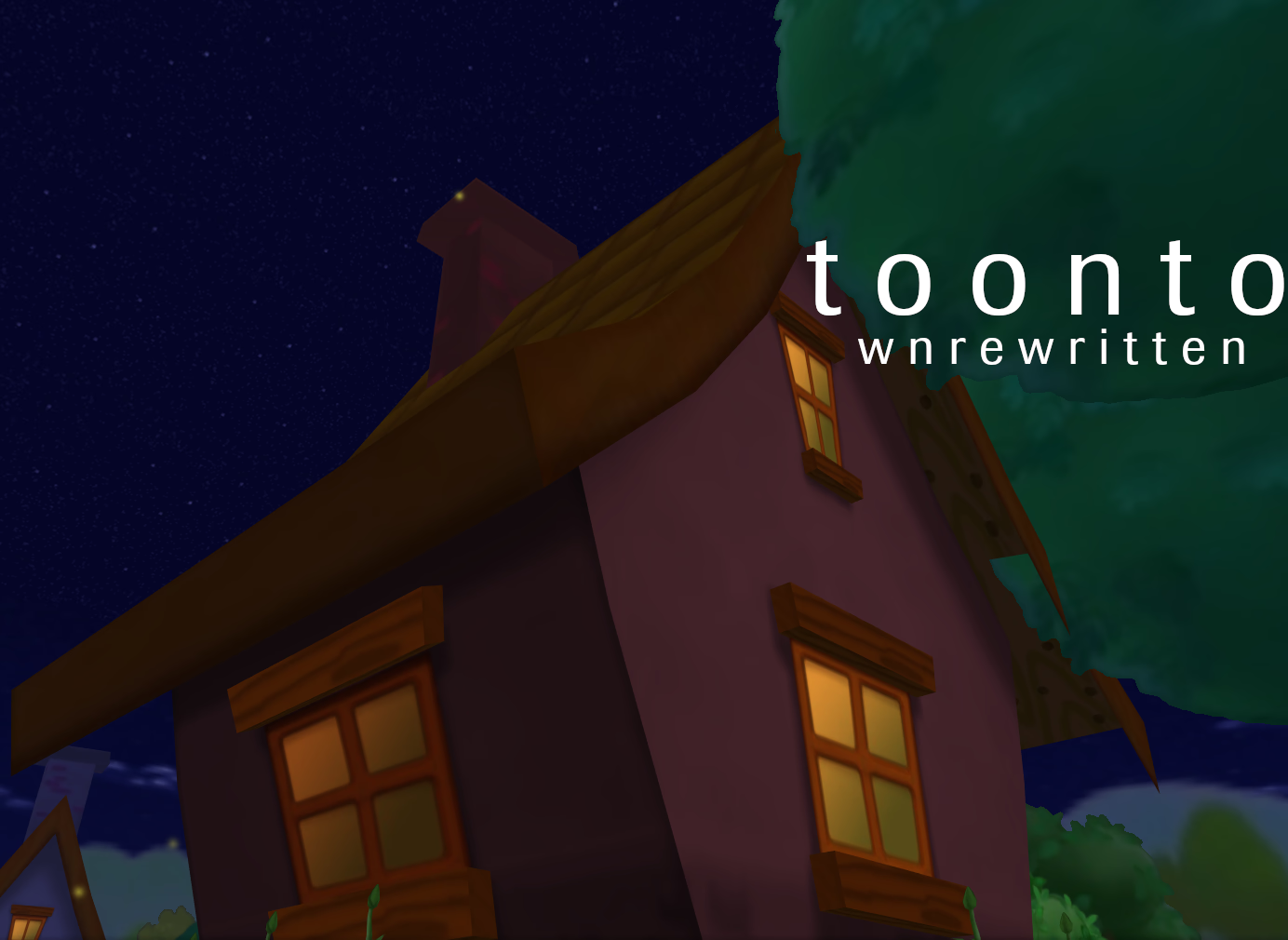
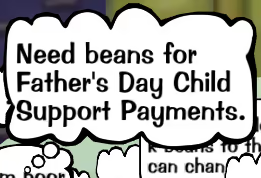
ℹ️ The following two images were carefully extracted from the unyielding clutches of 𝕏itter™® (pronounced /ˈʃɪt.ə(ɹ)/), adapted from No Context Toontown (@NoContextTTO) posts.
![[crimson cat]: I saw the virus two months before it hit the world [crimson cat]: I saw the virus two months before it hit the world](https://deer.codeberg.page/tt_diary/008/before-it-hit-the-world.webp)
@panfluidprodigy).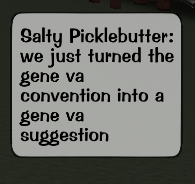
@oneangeryboy).